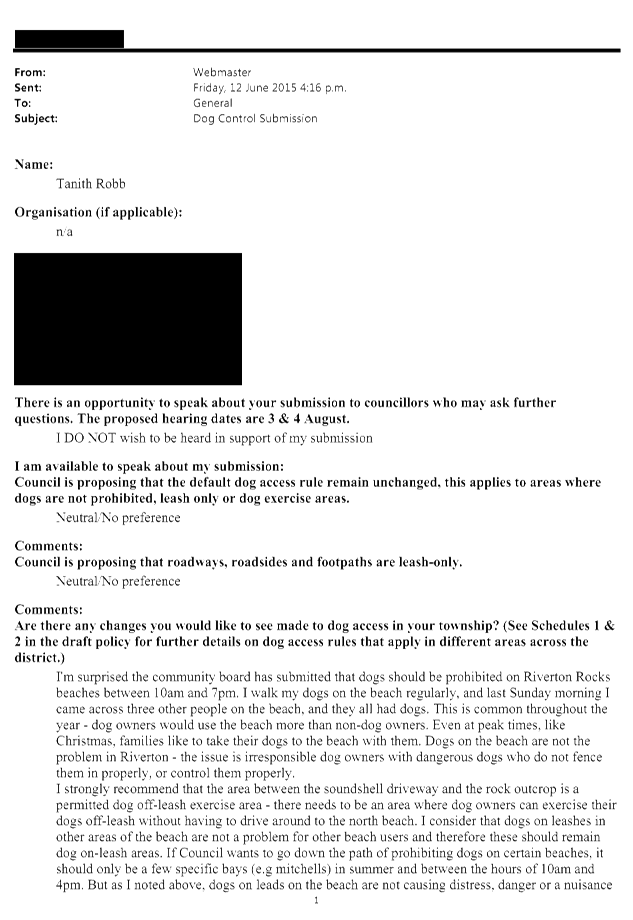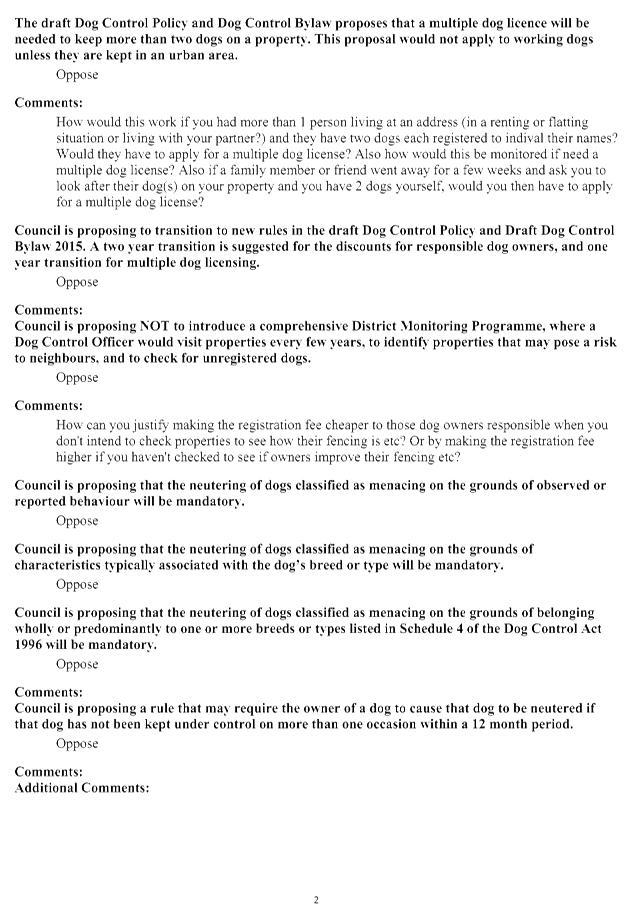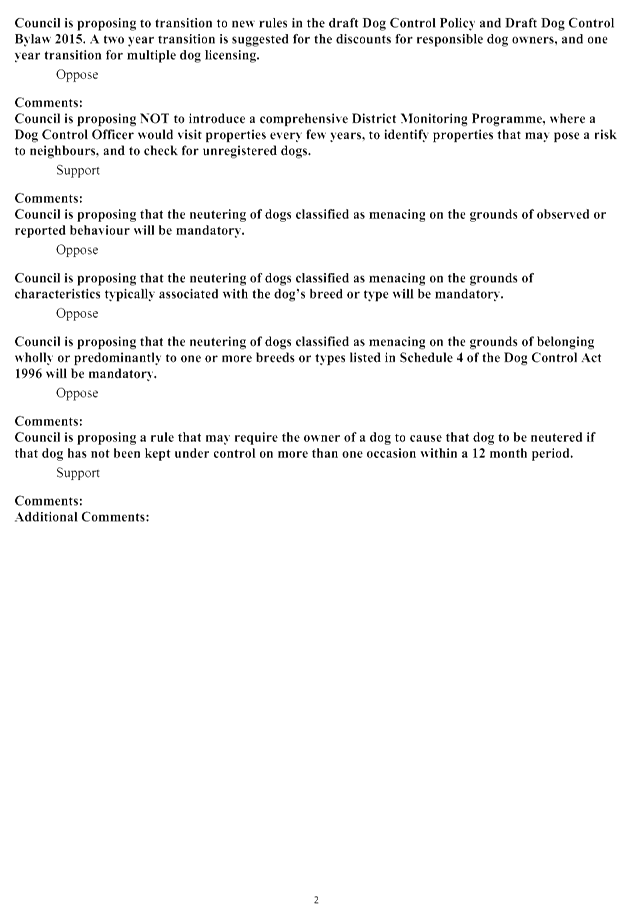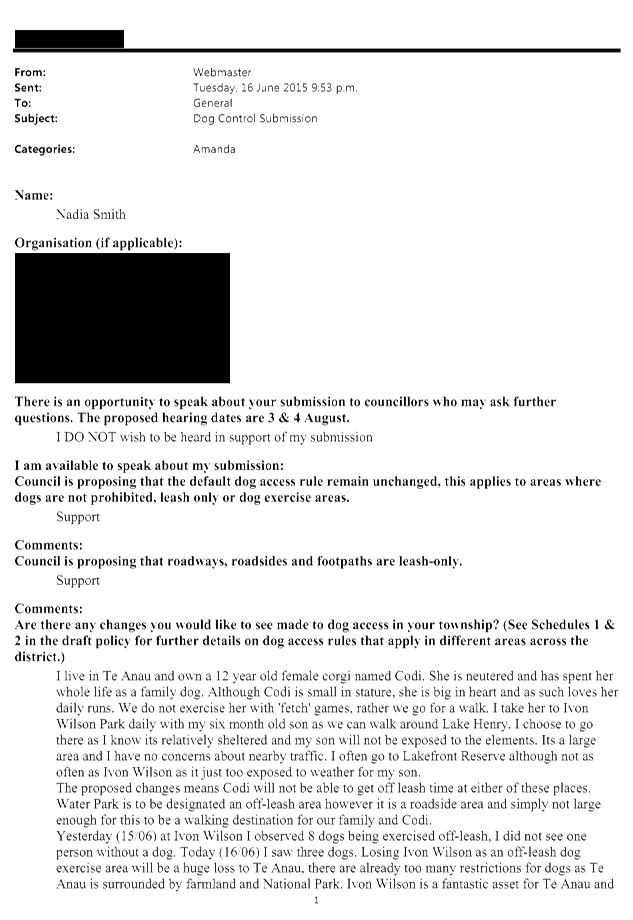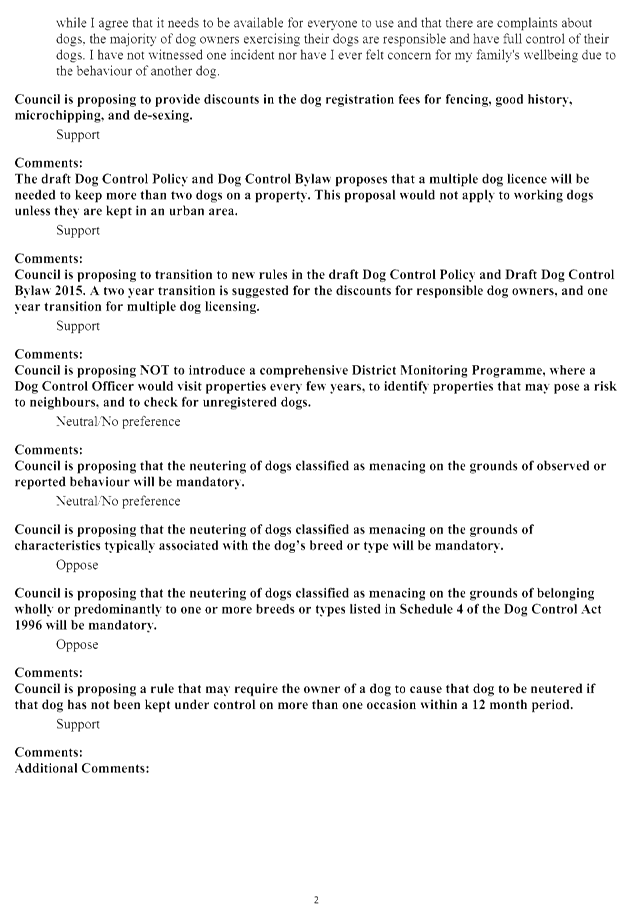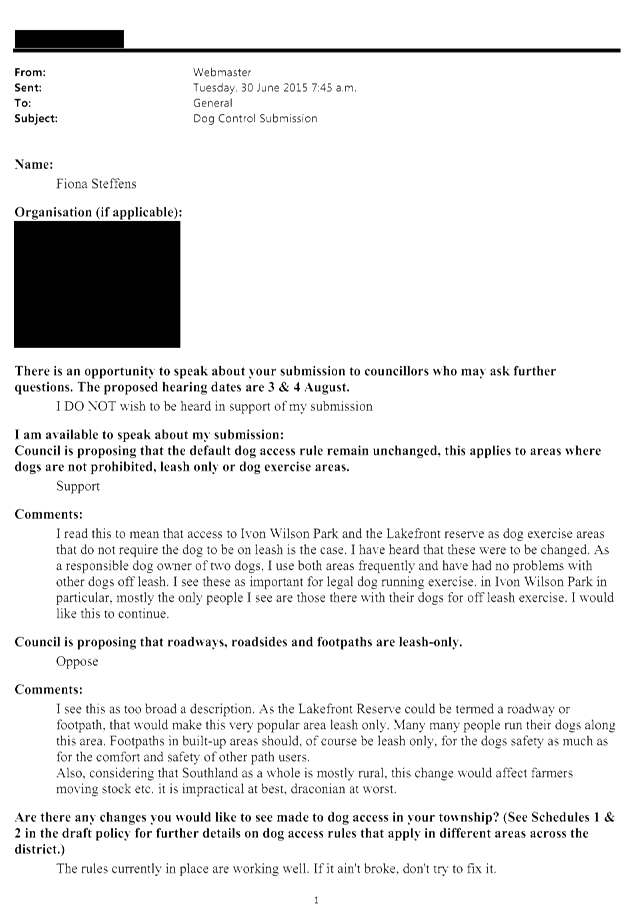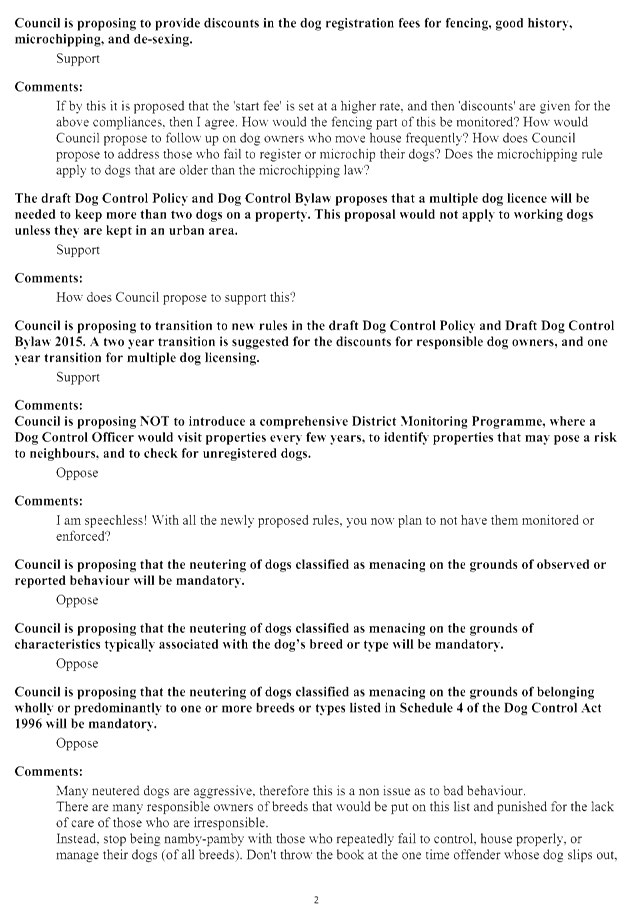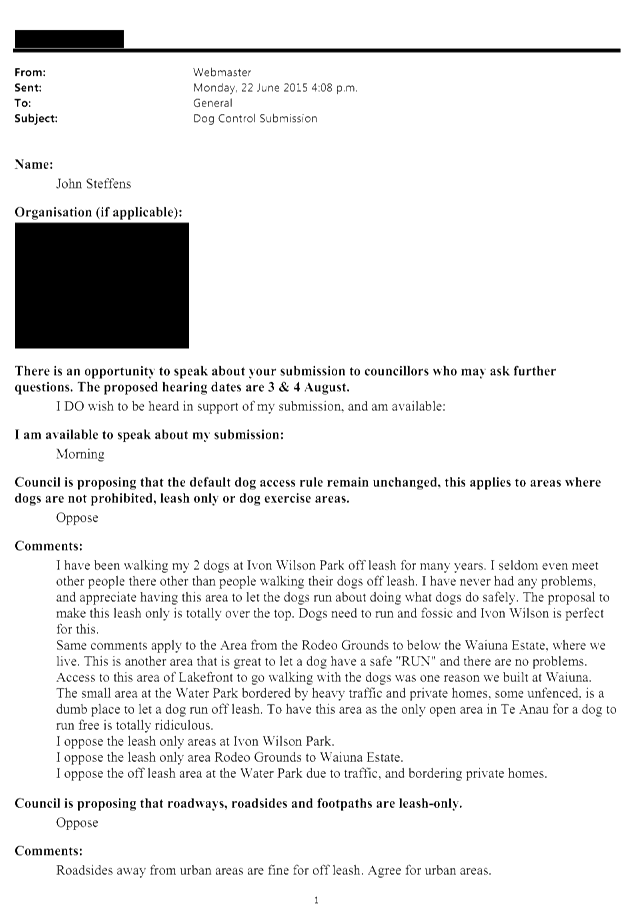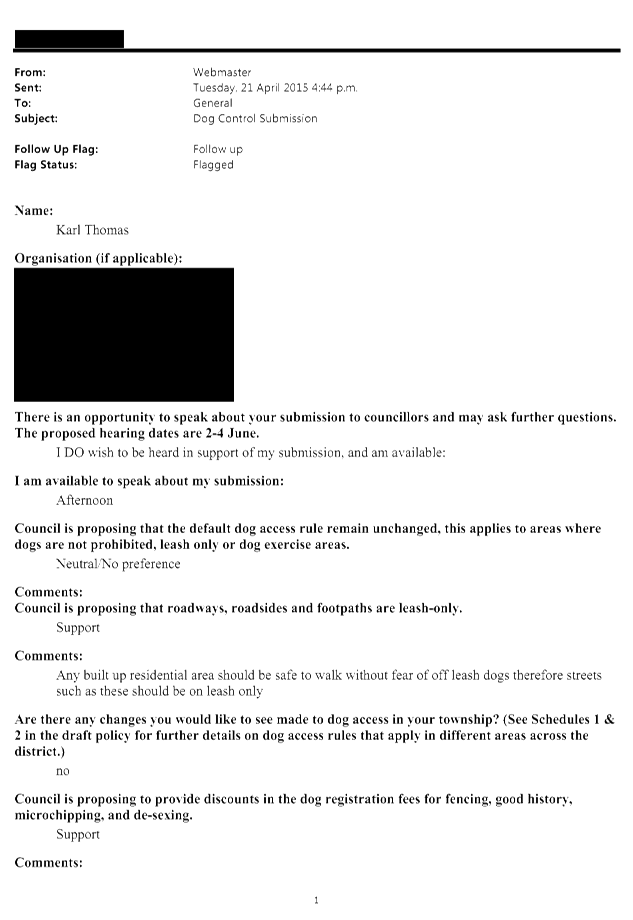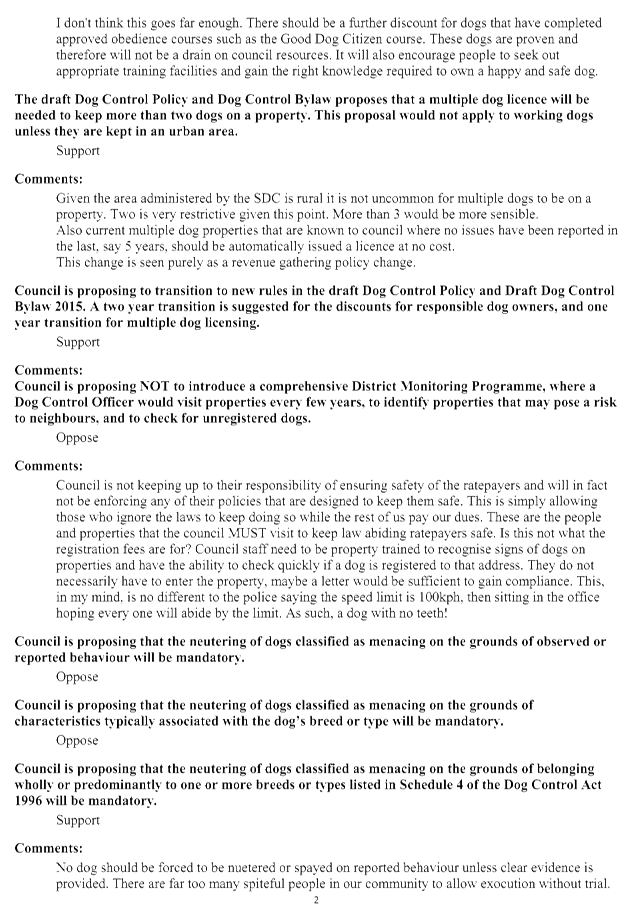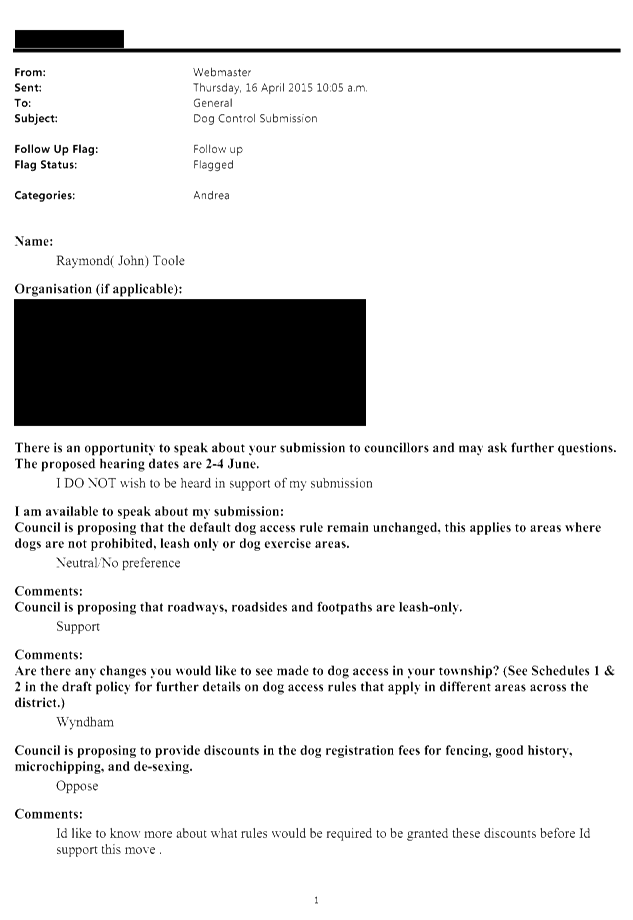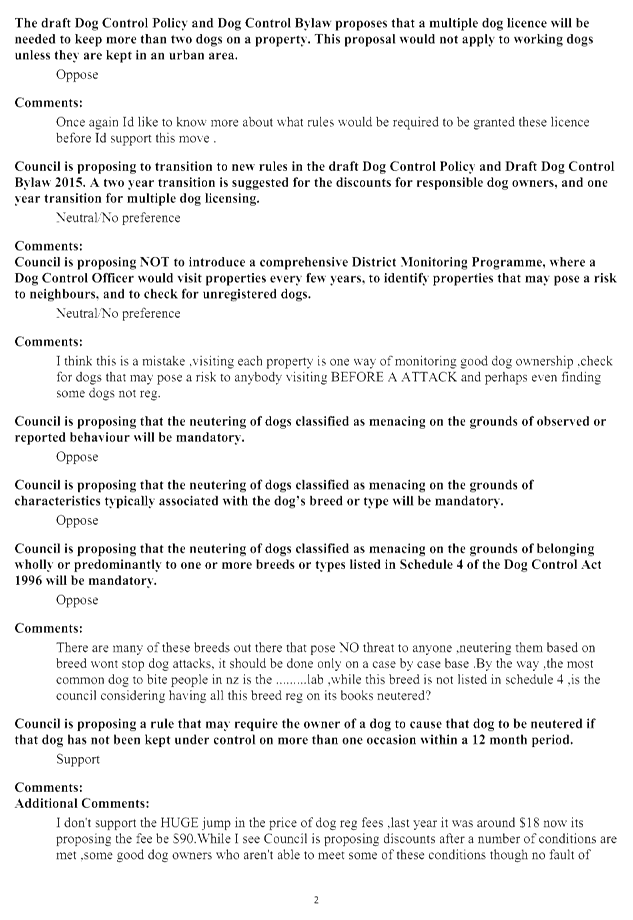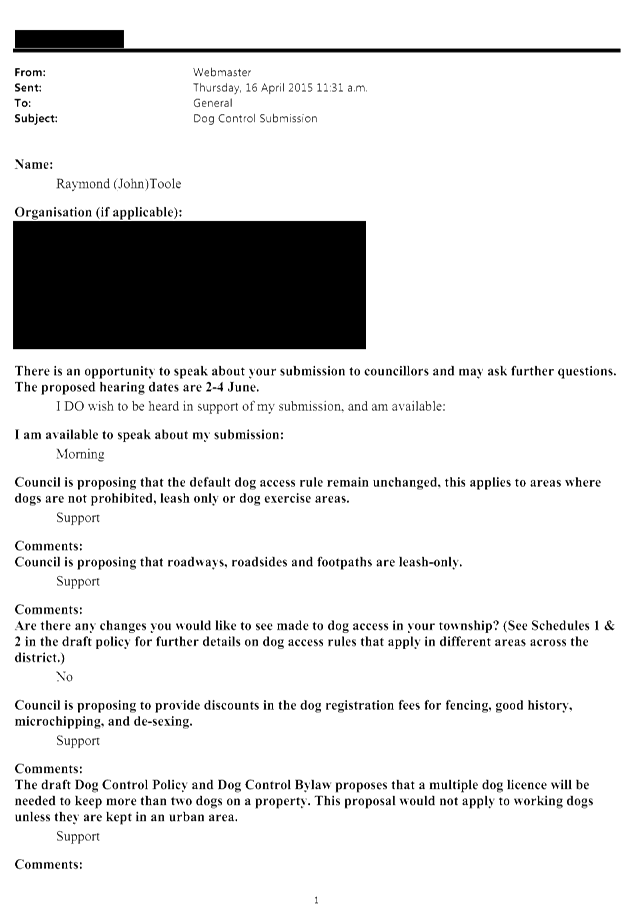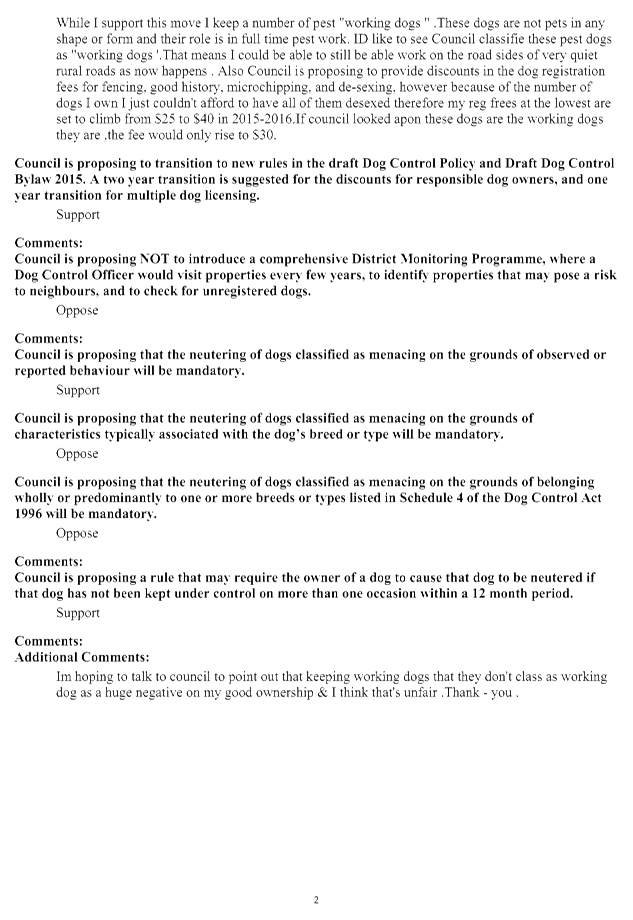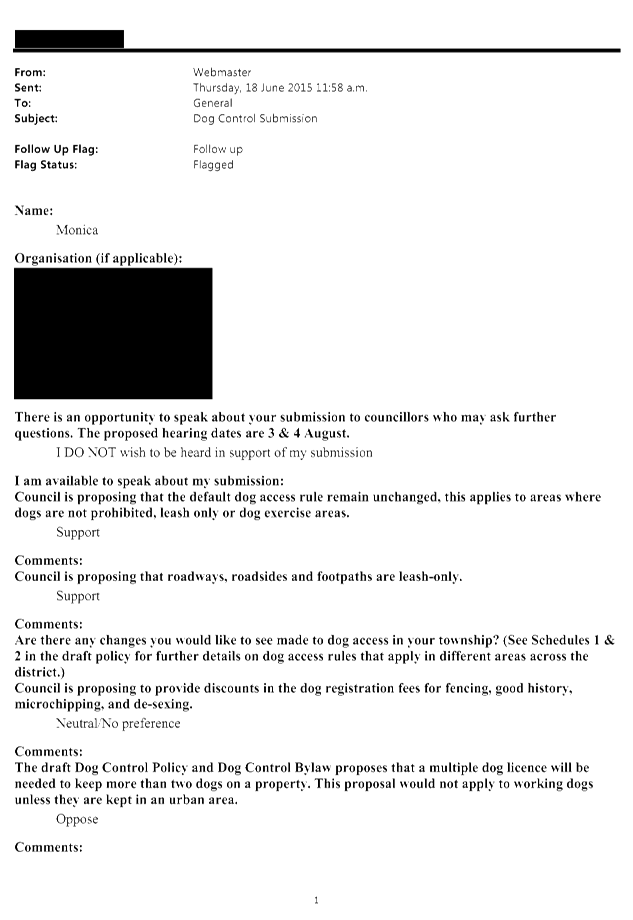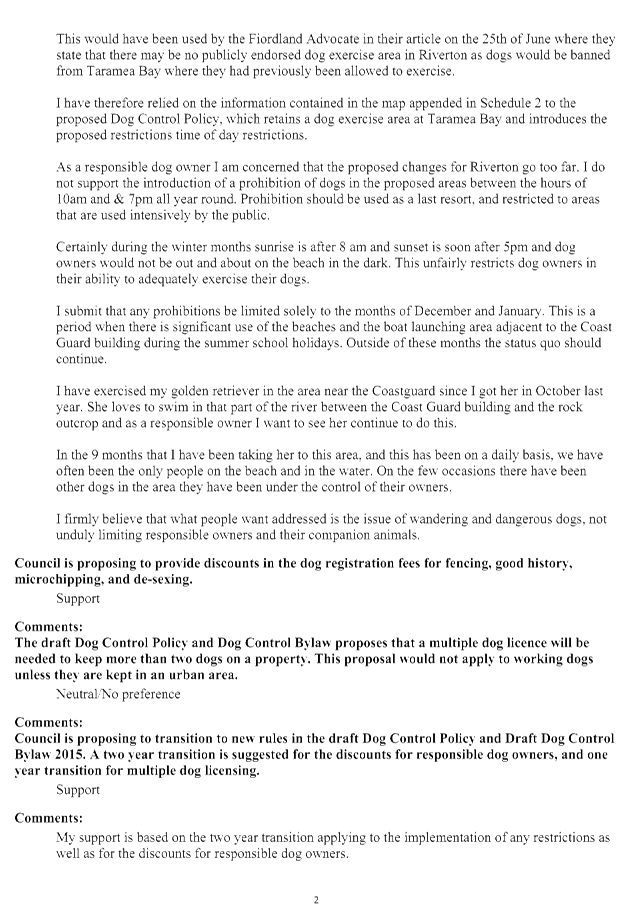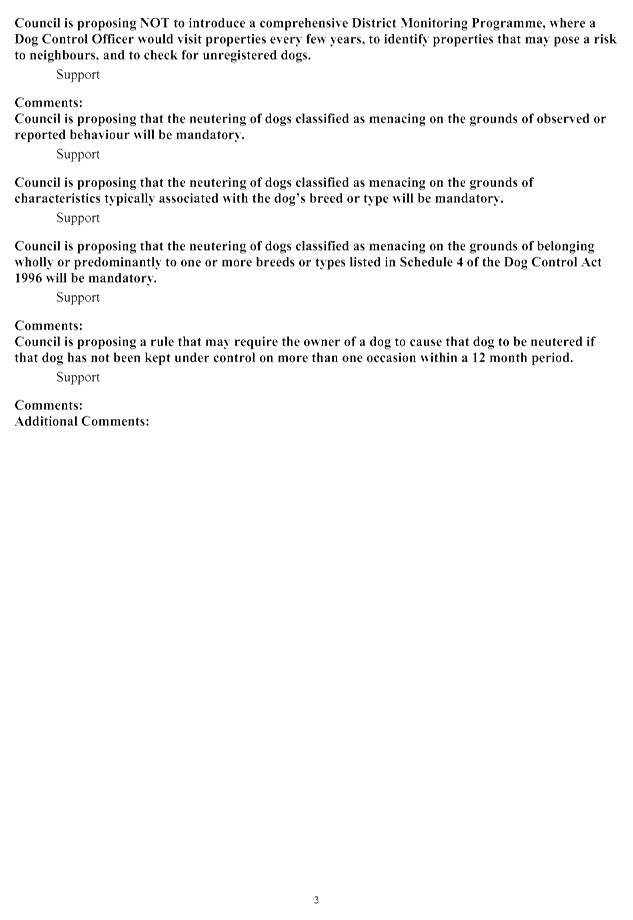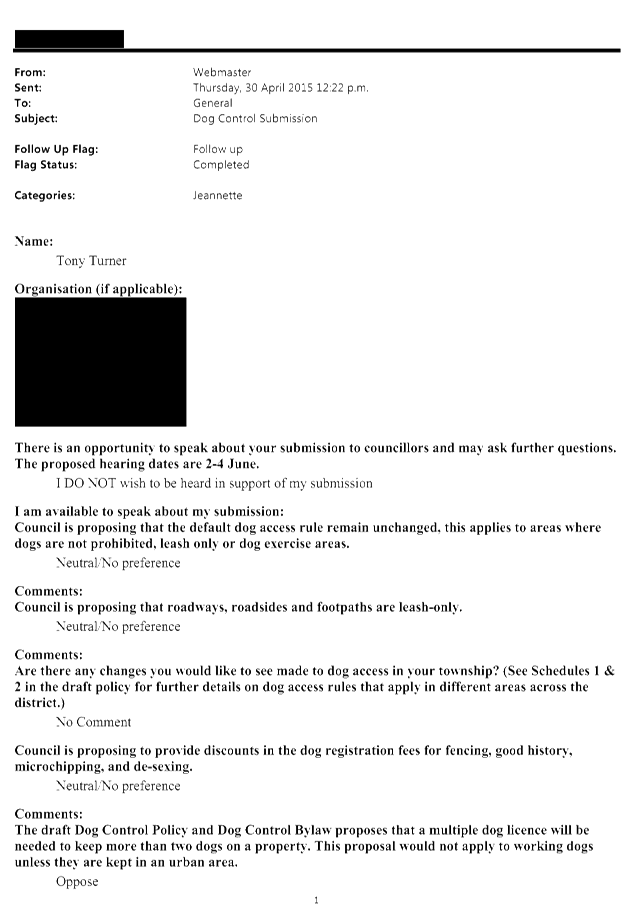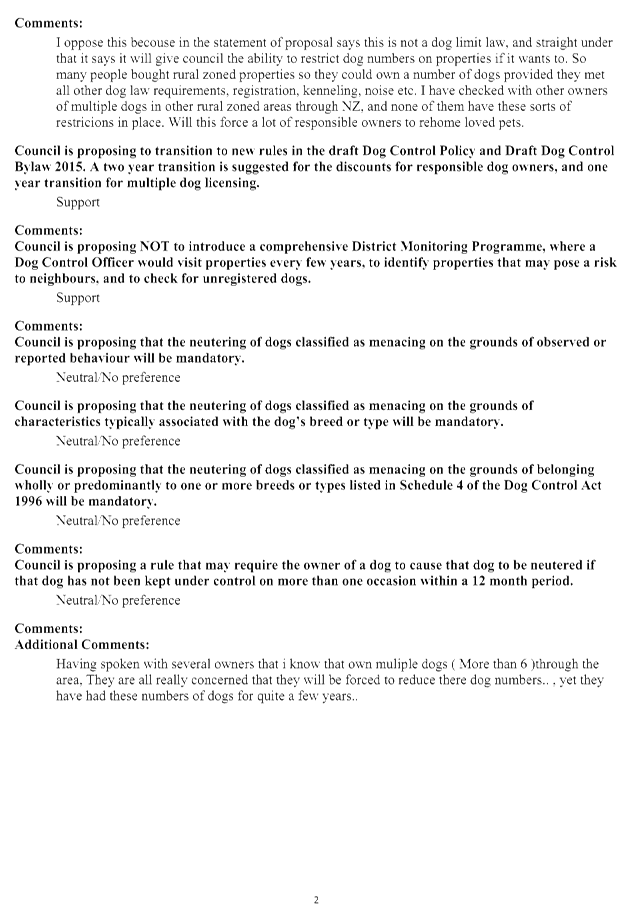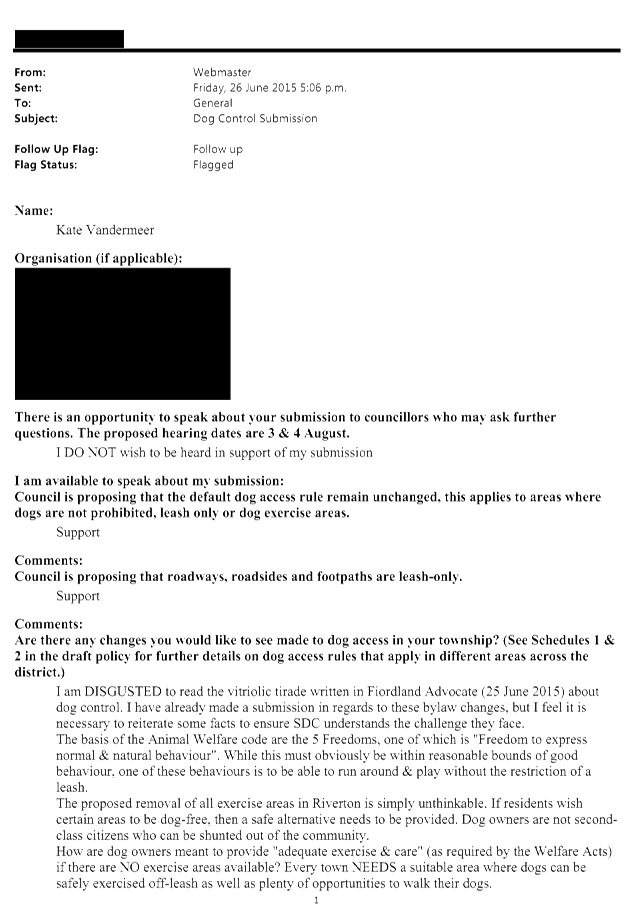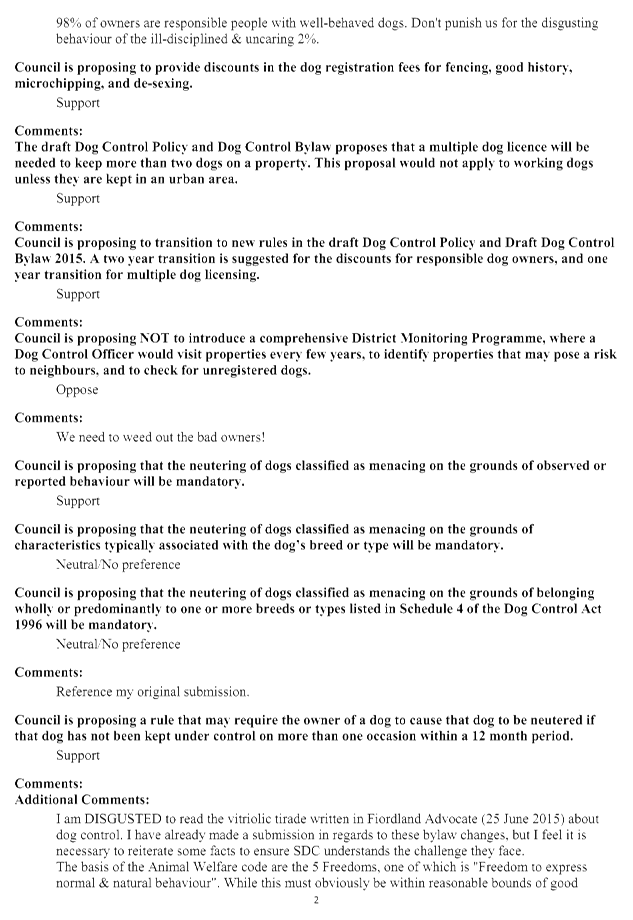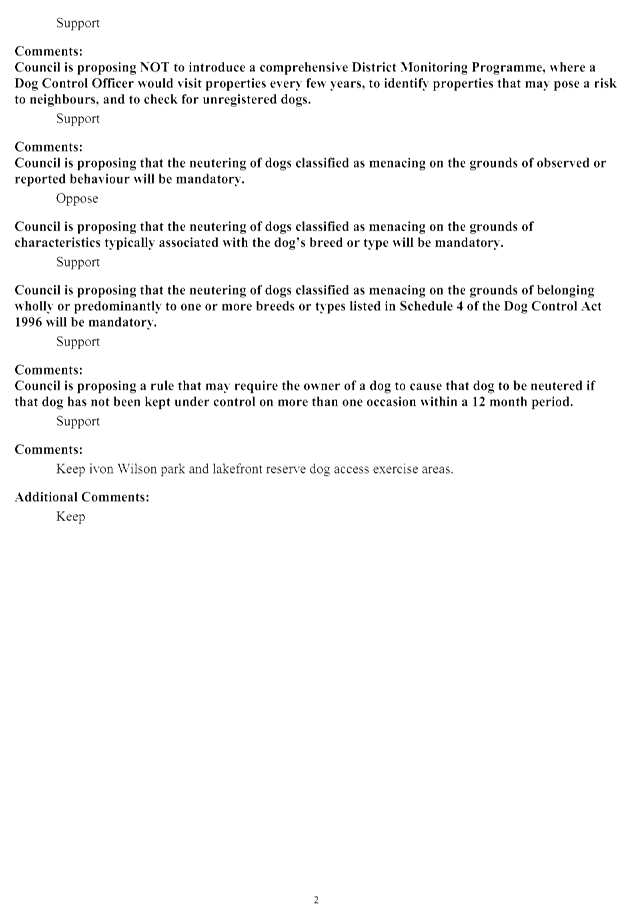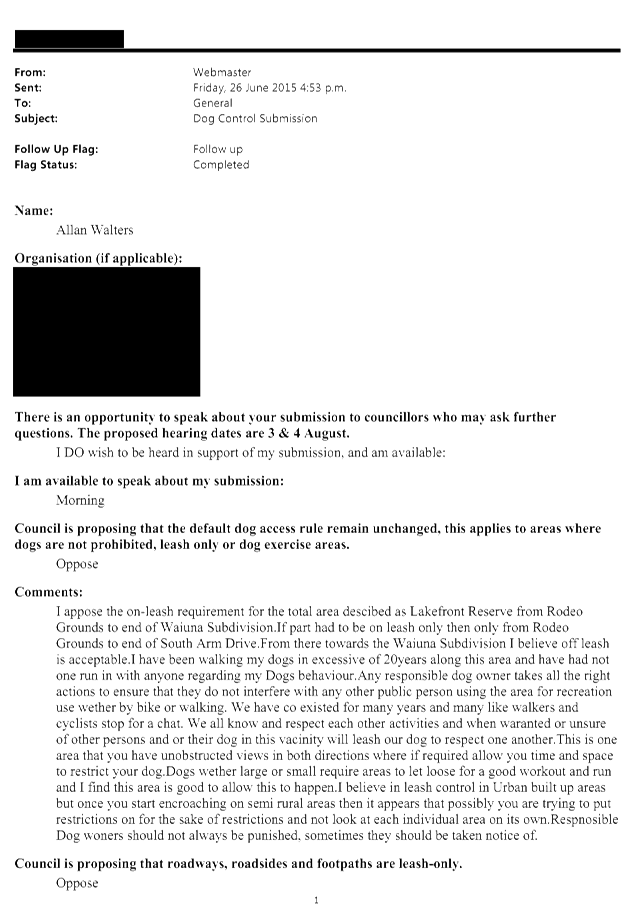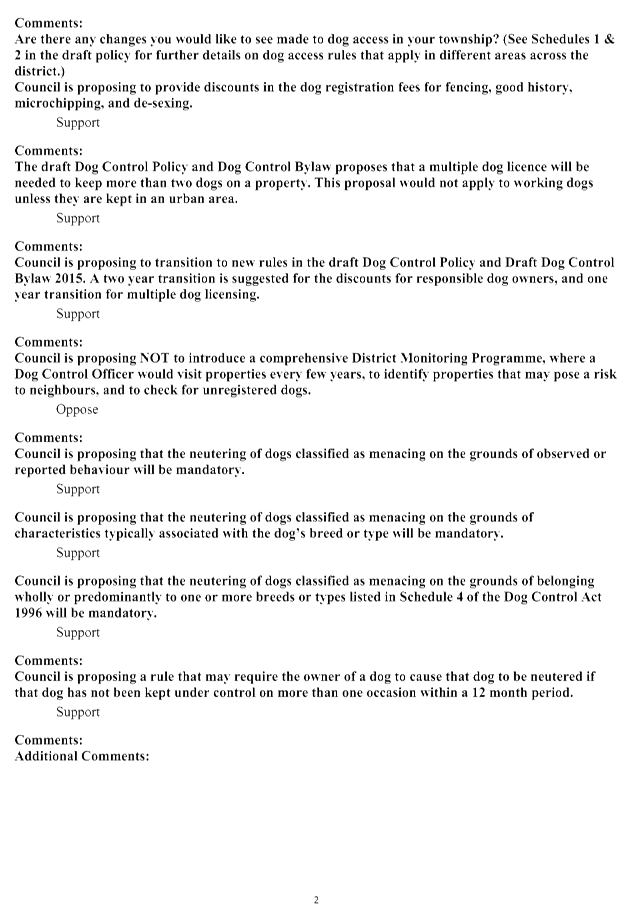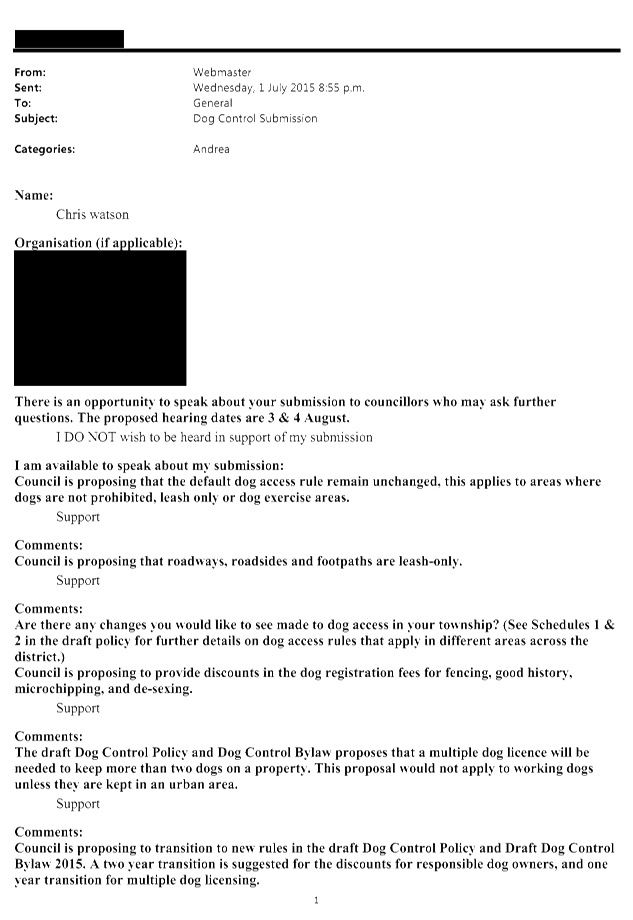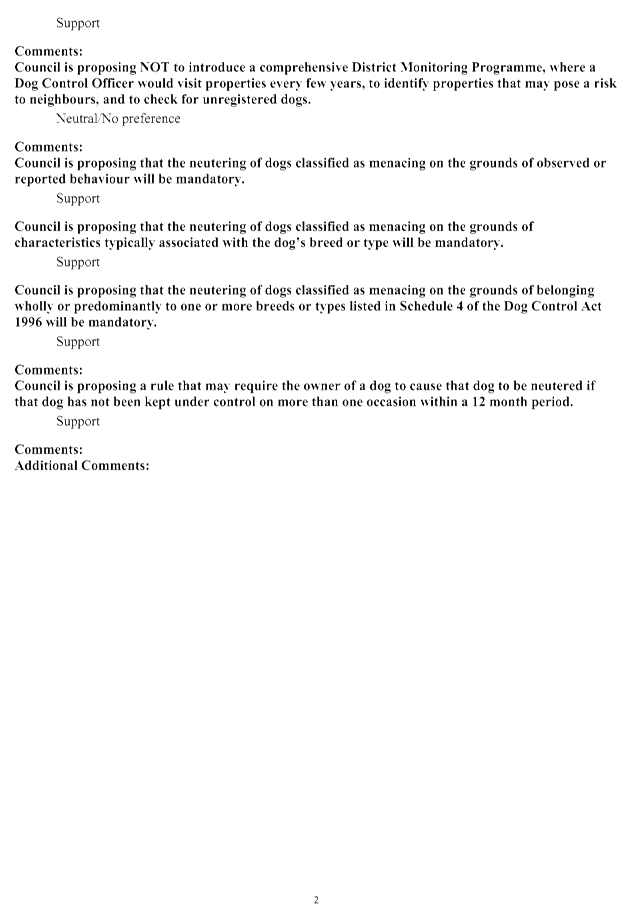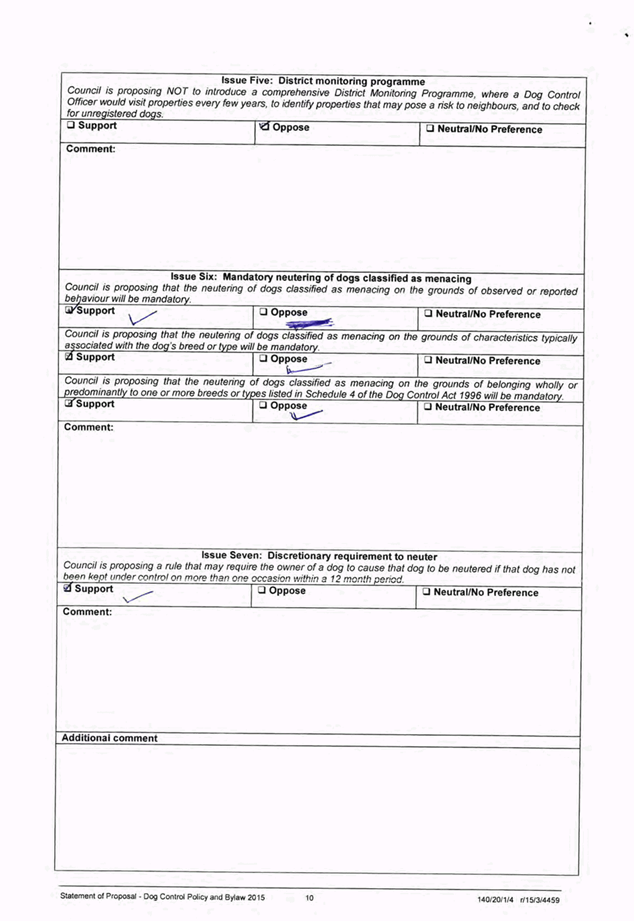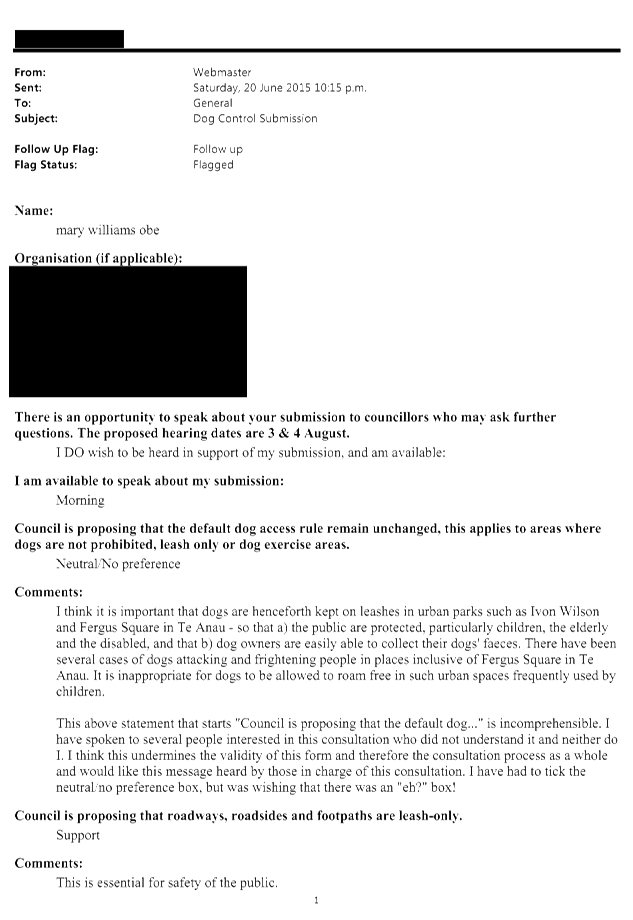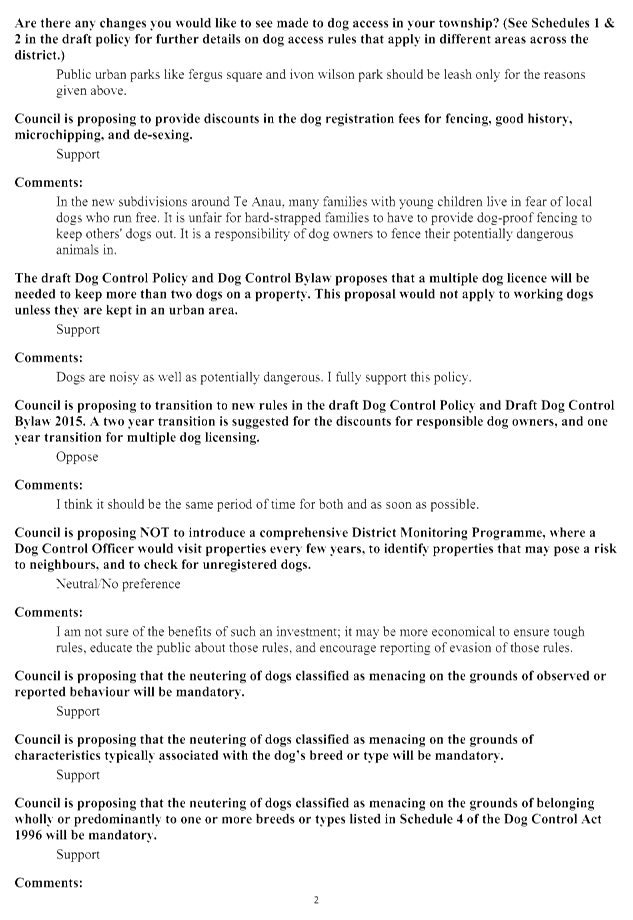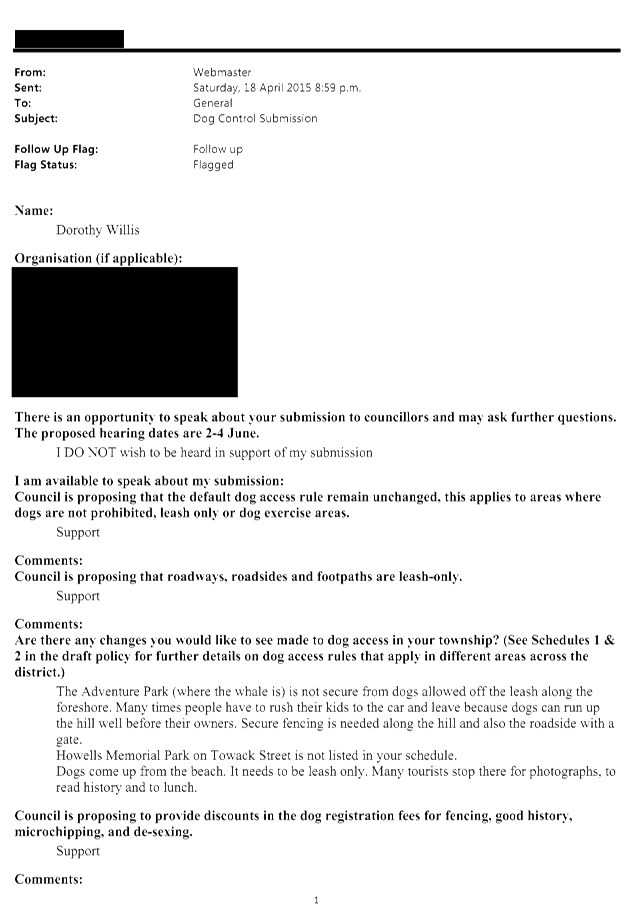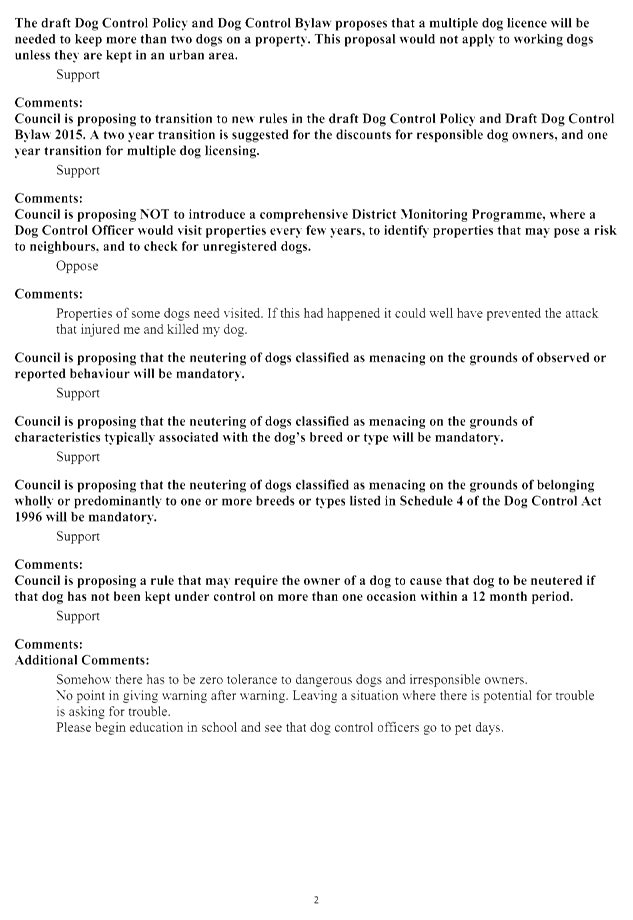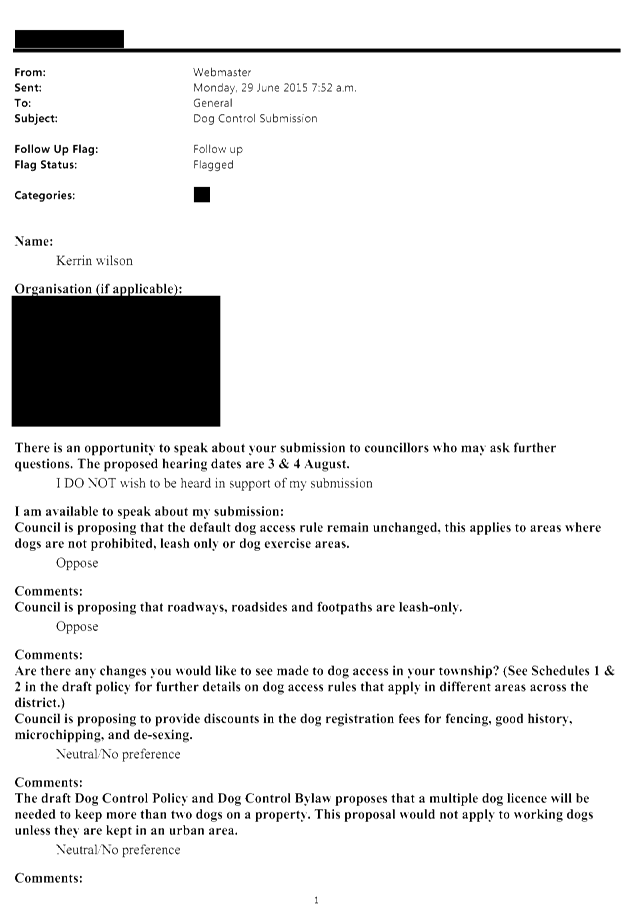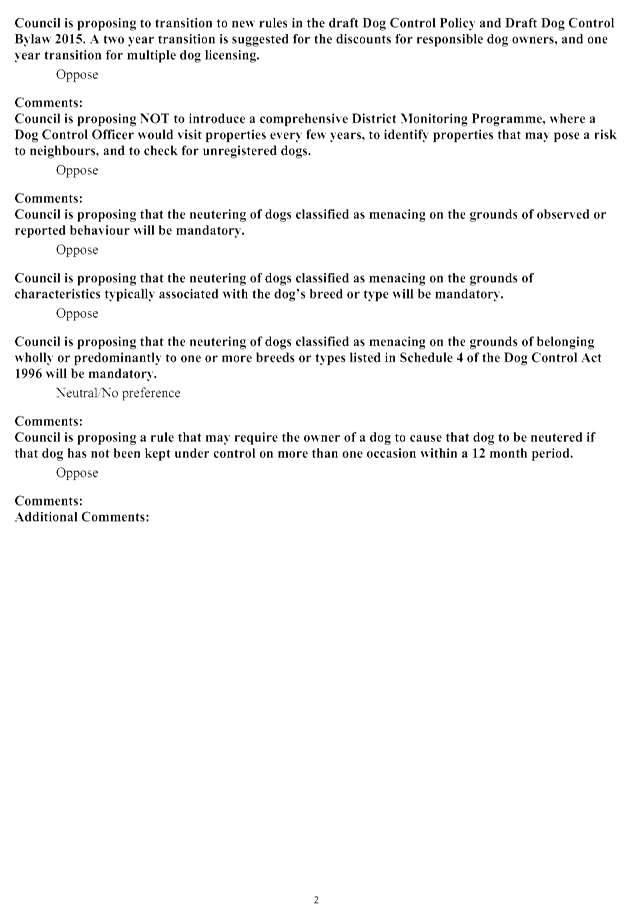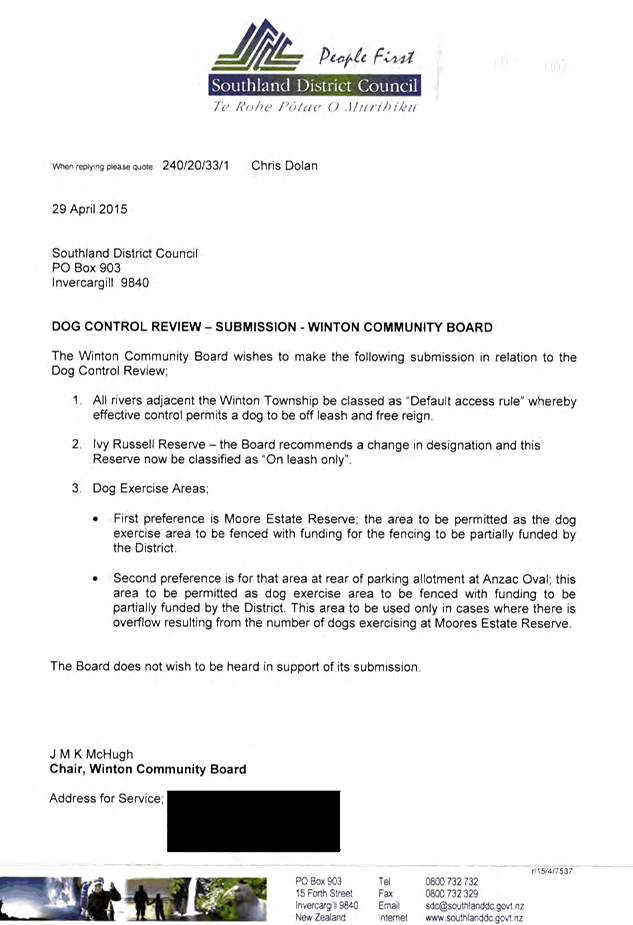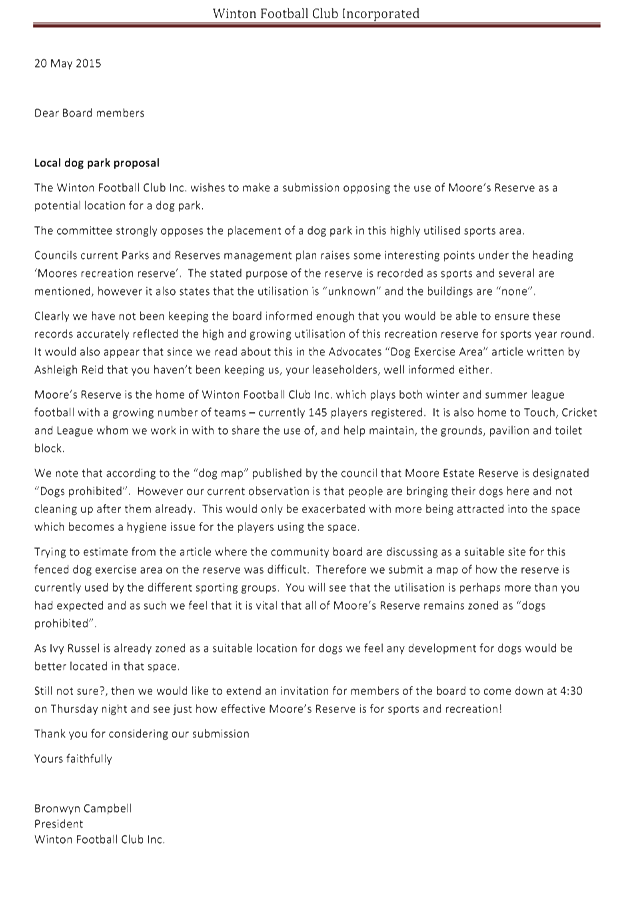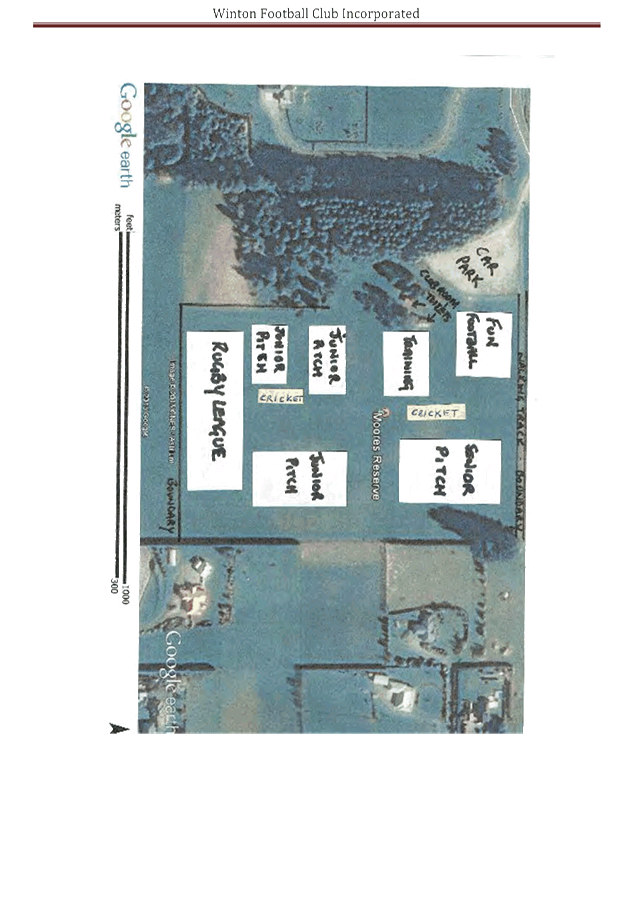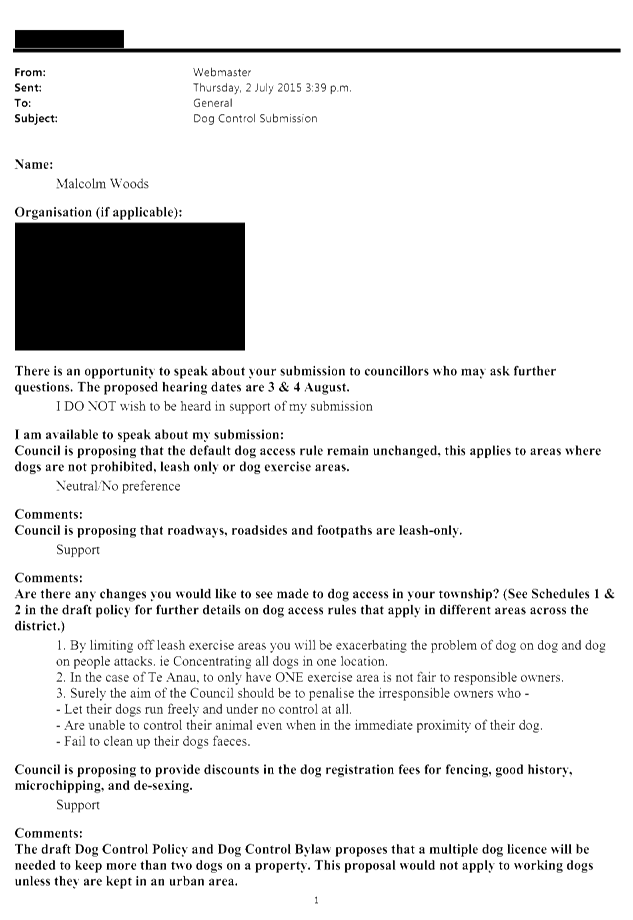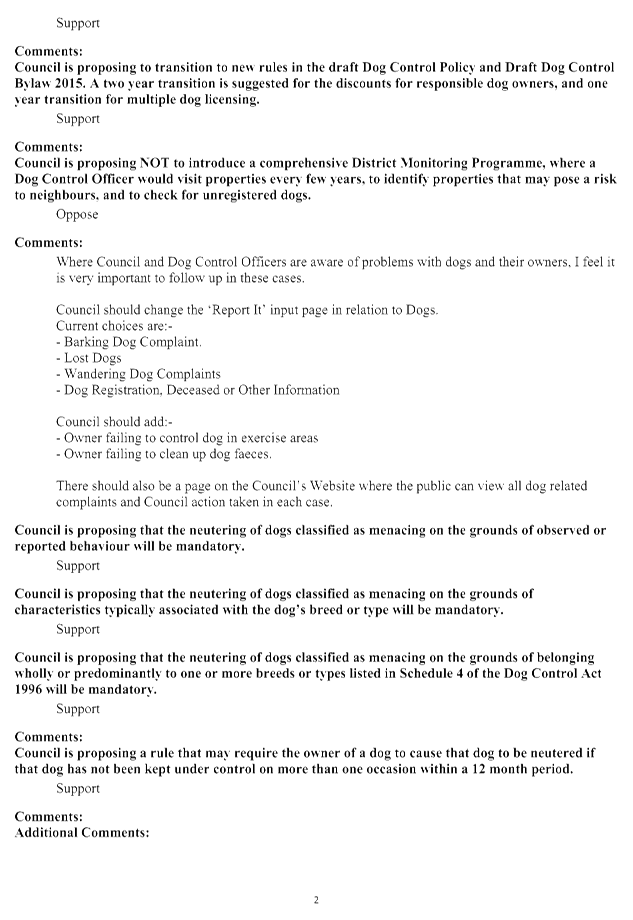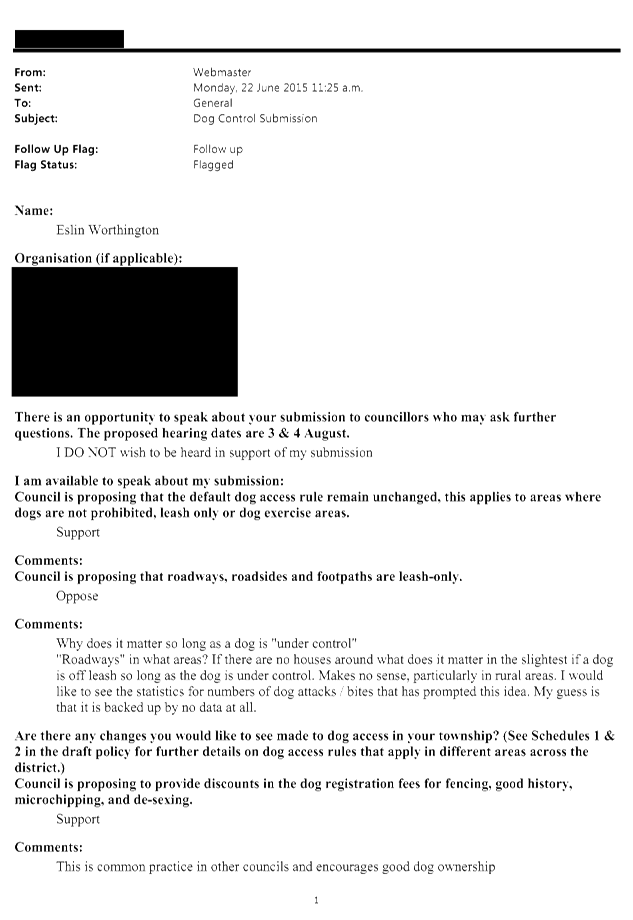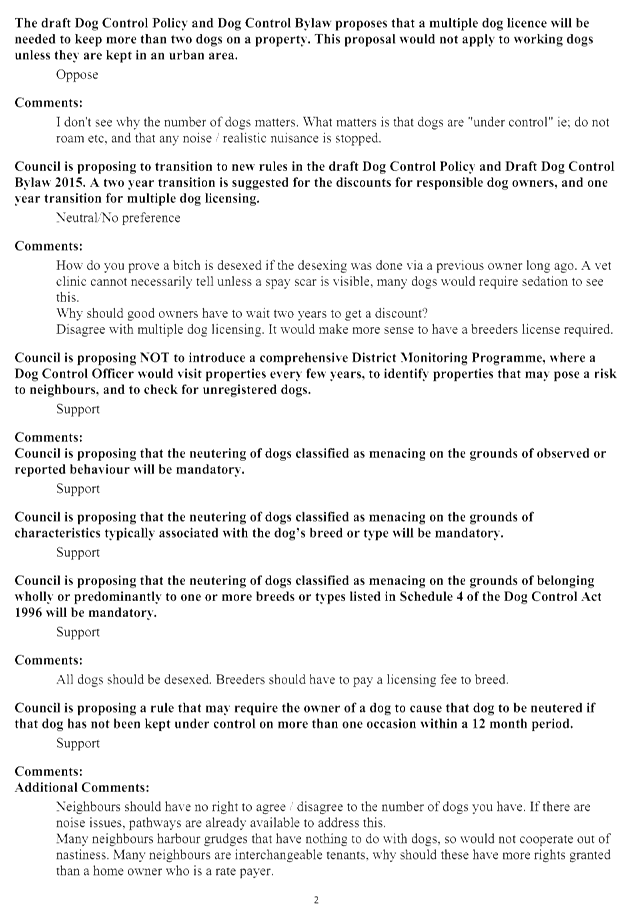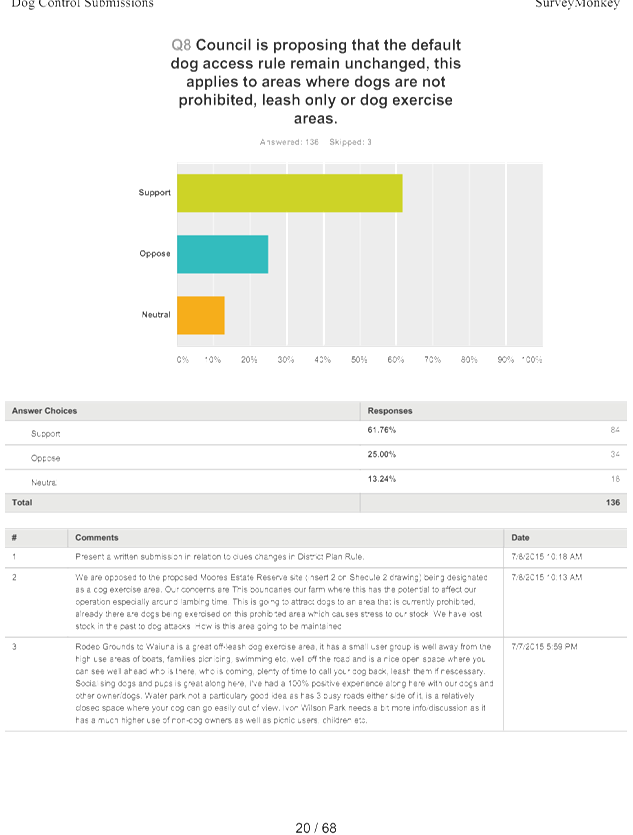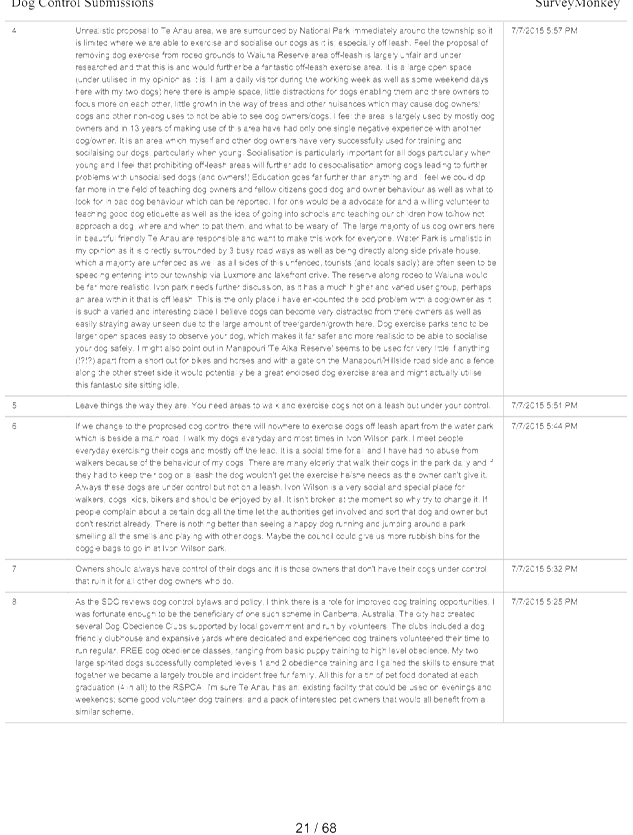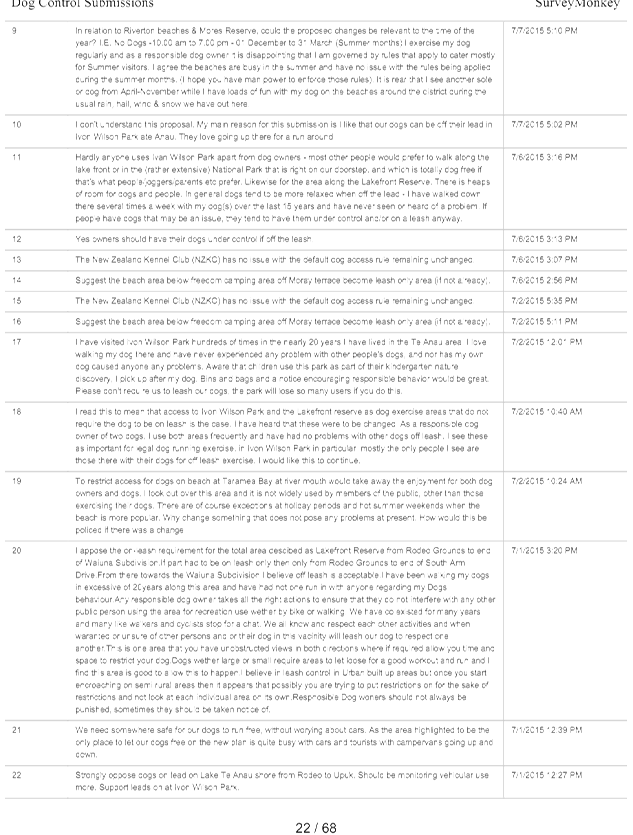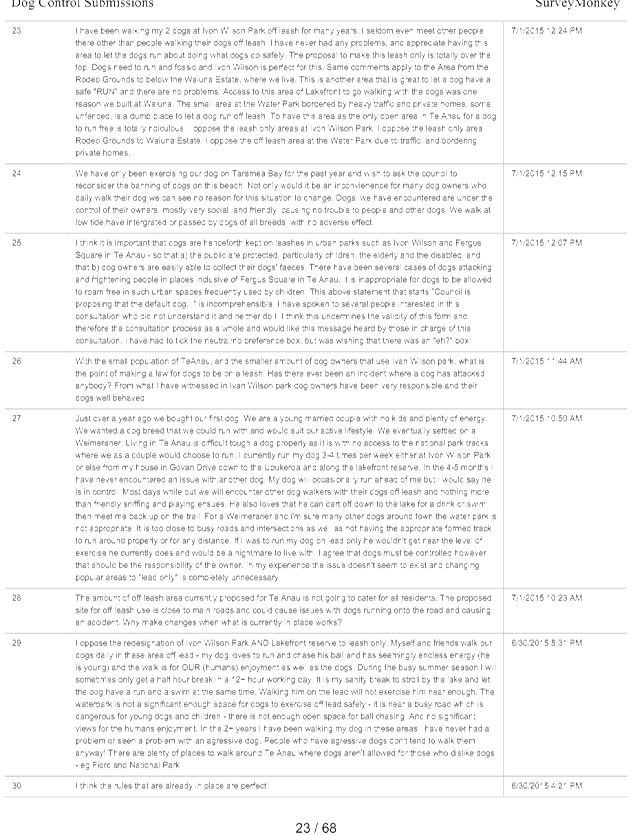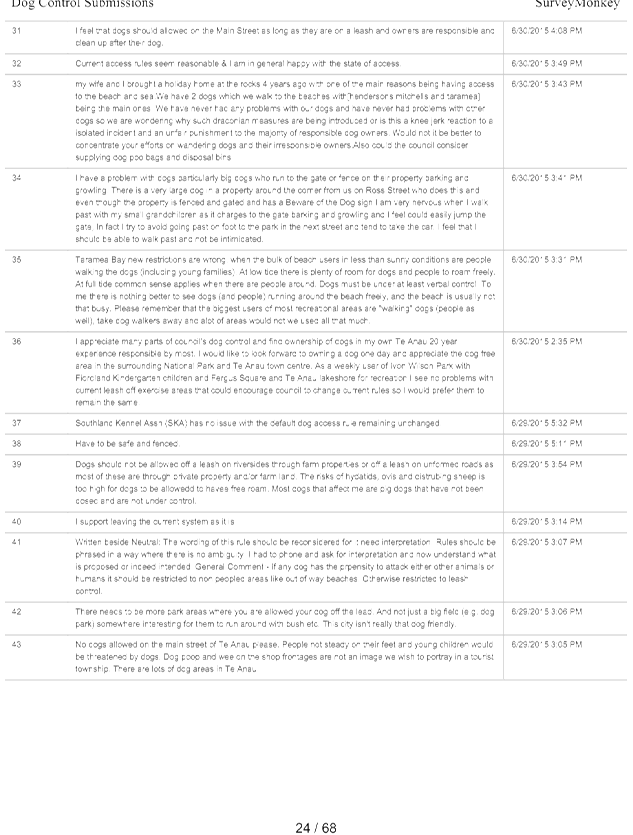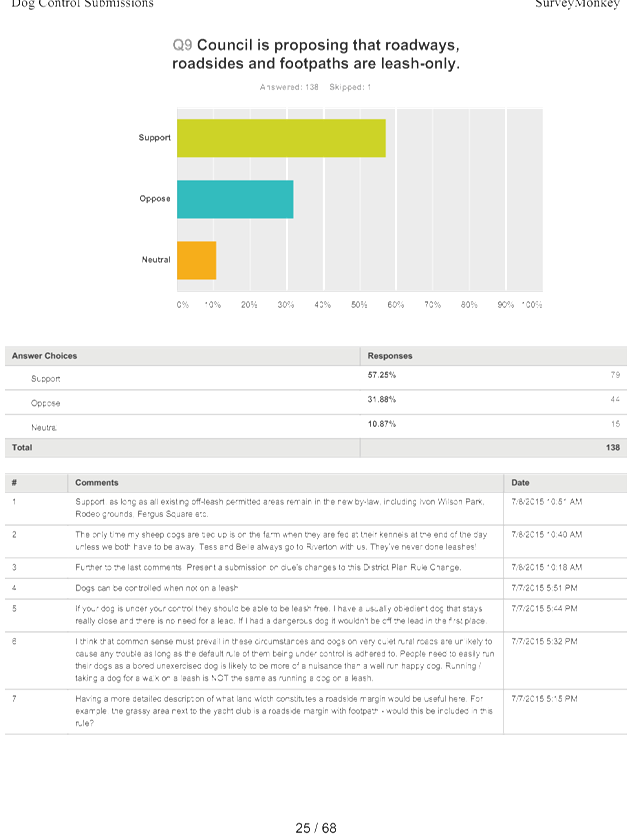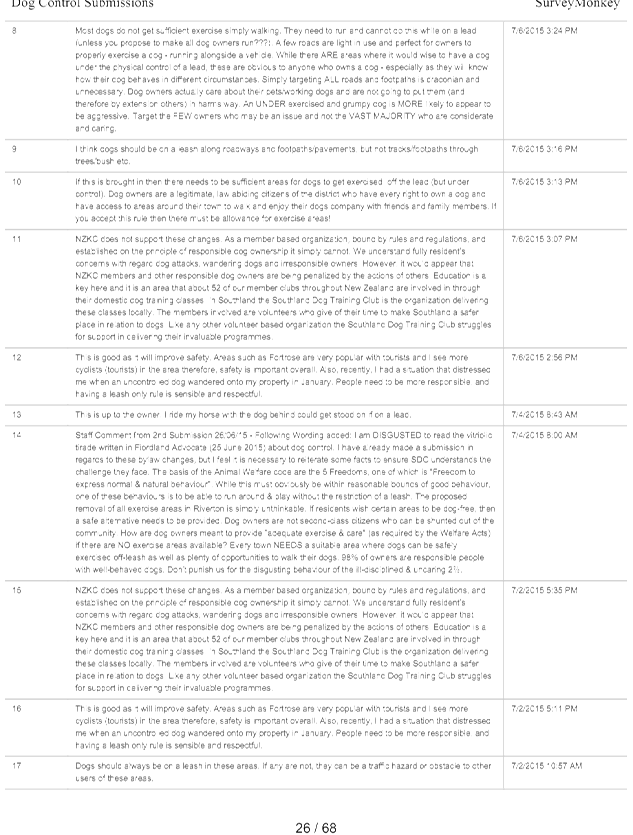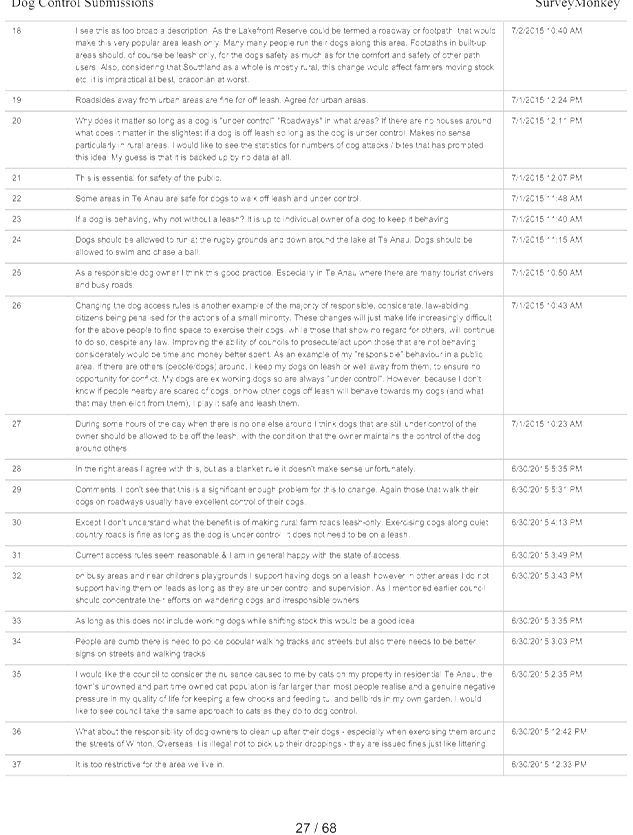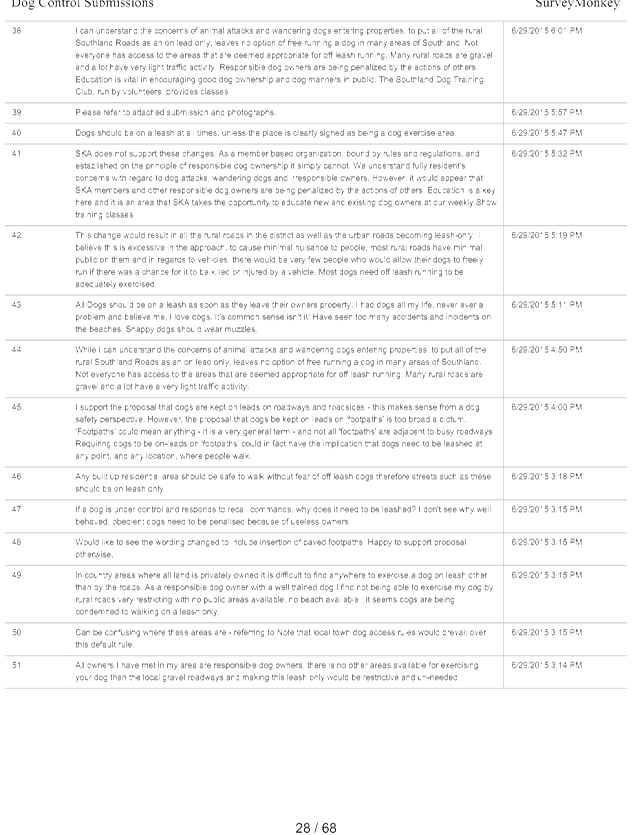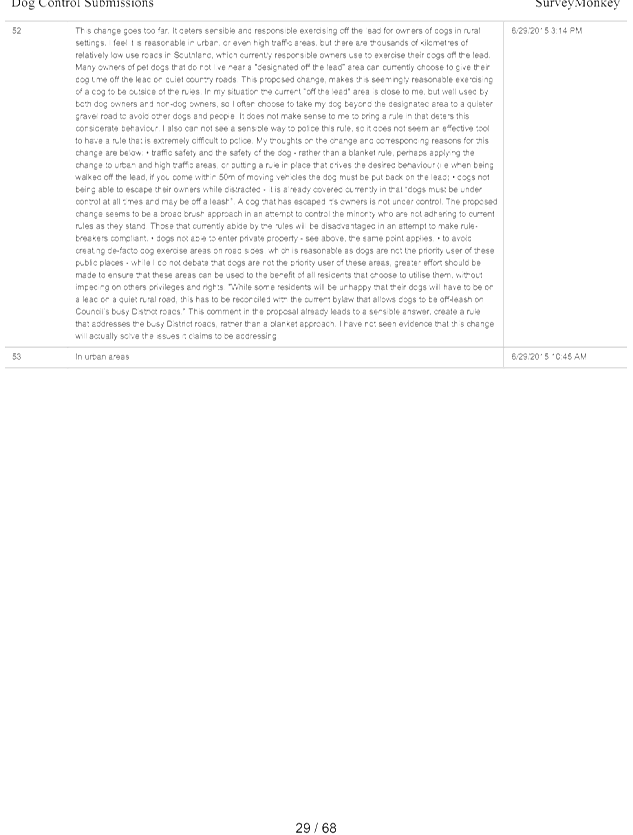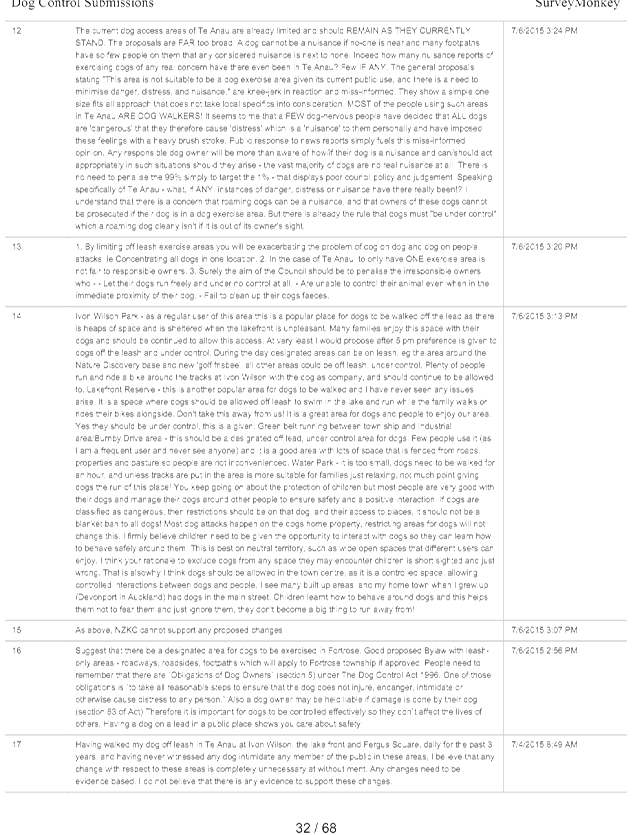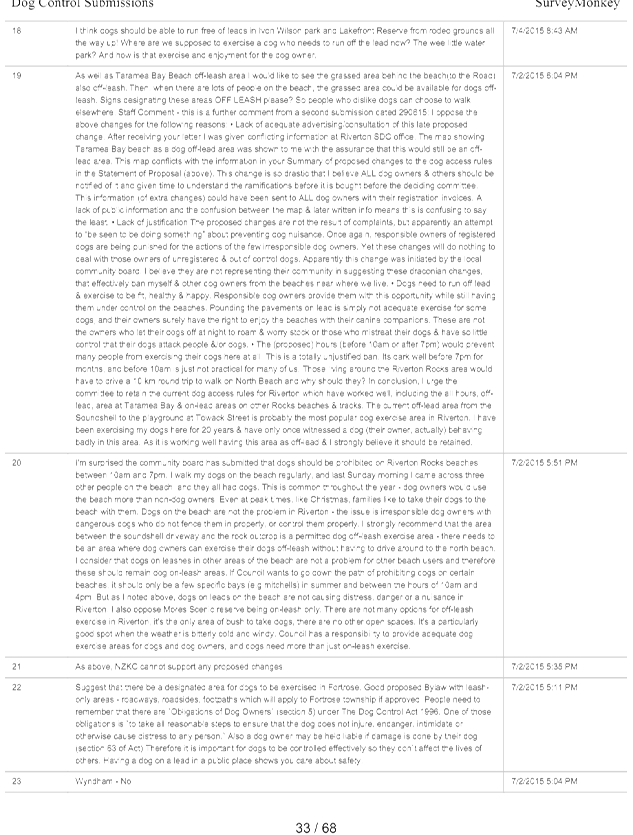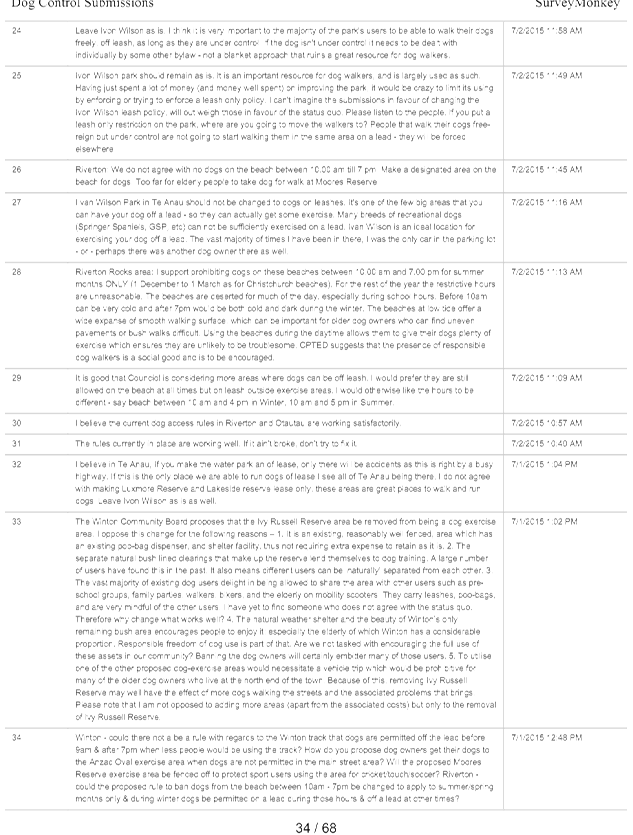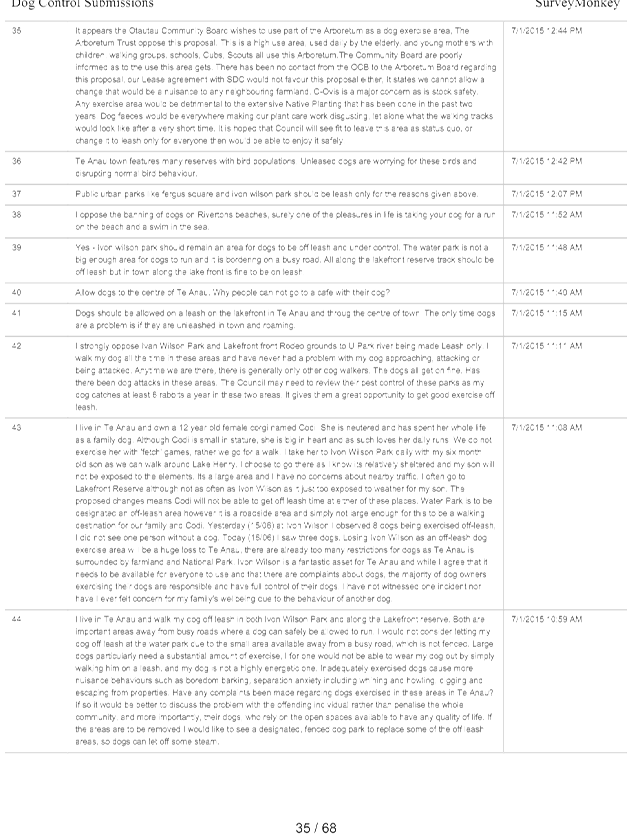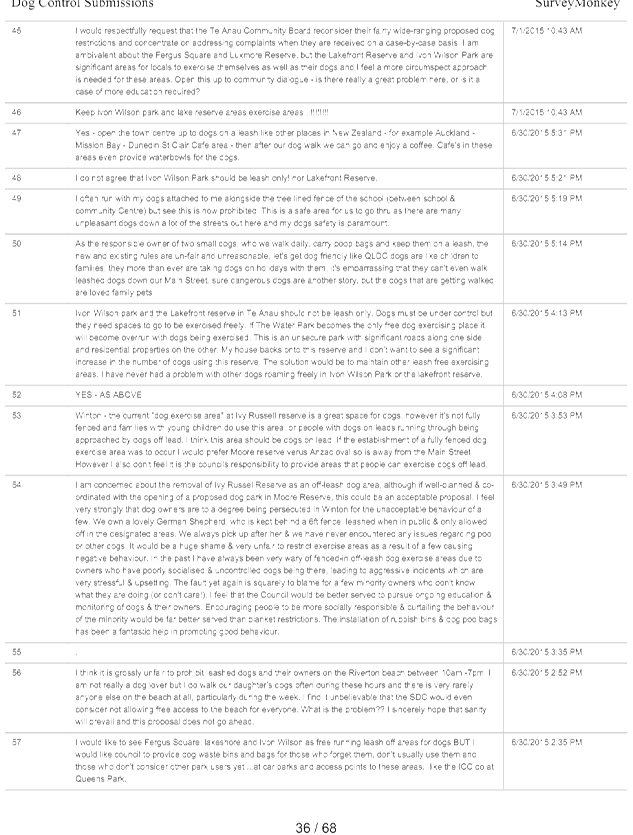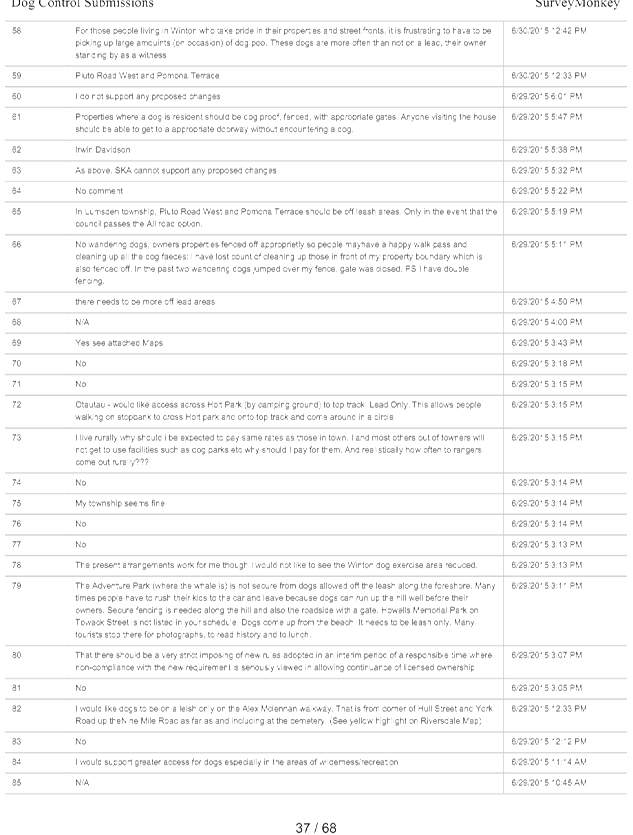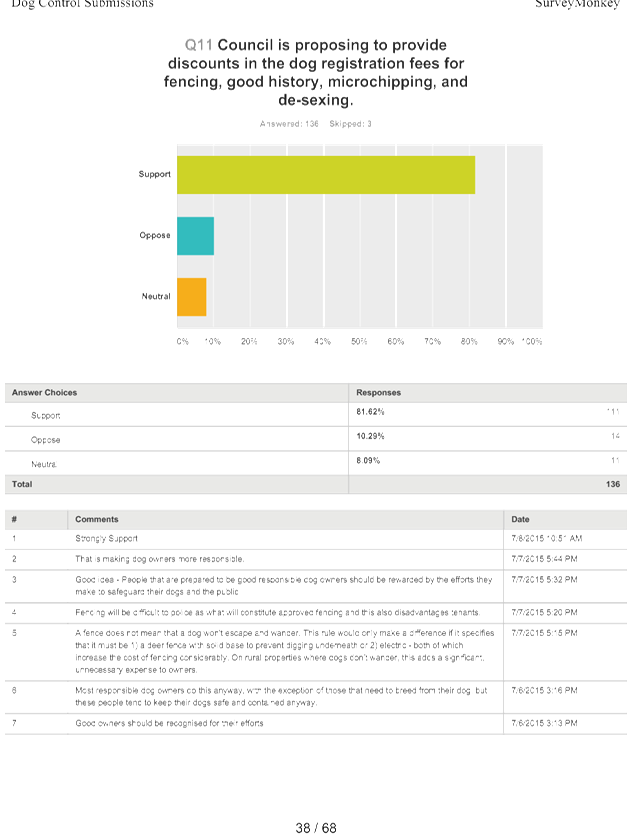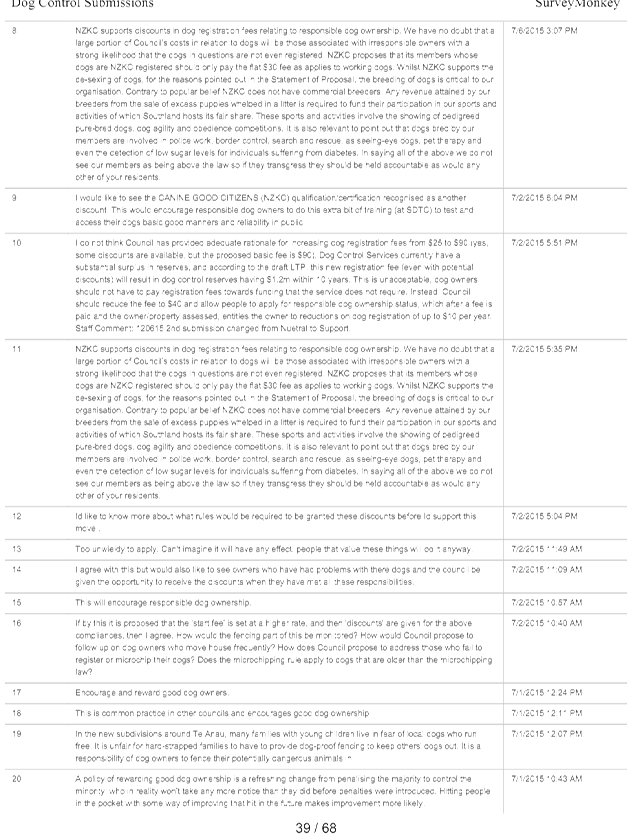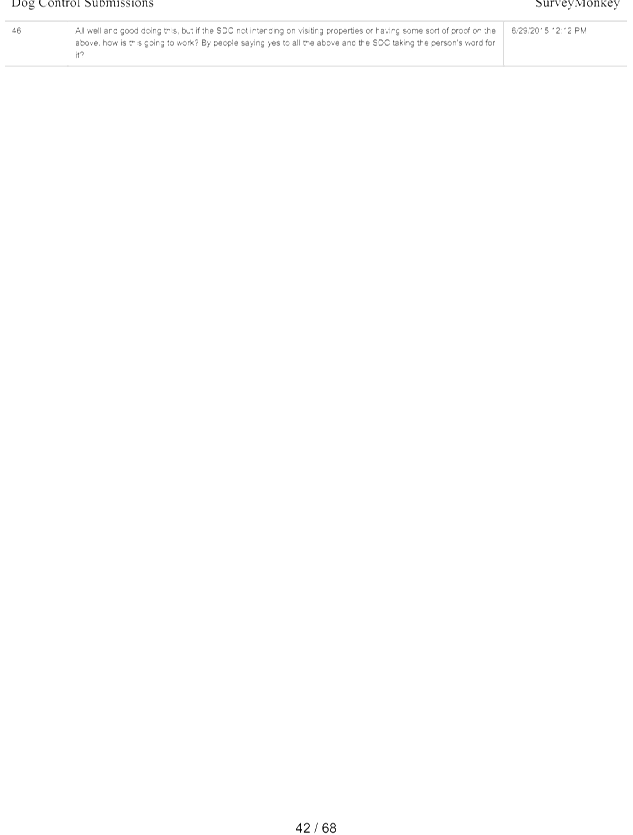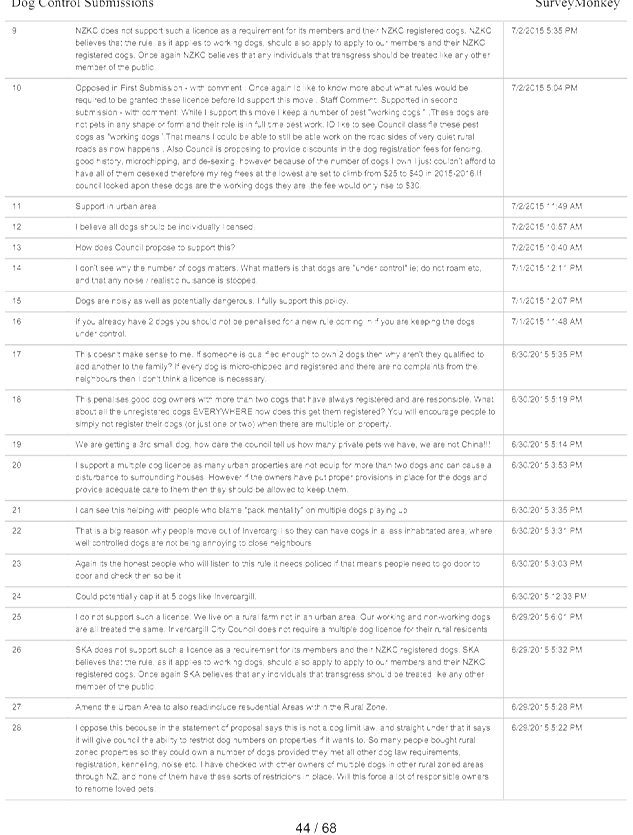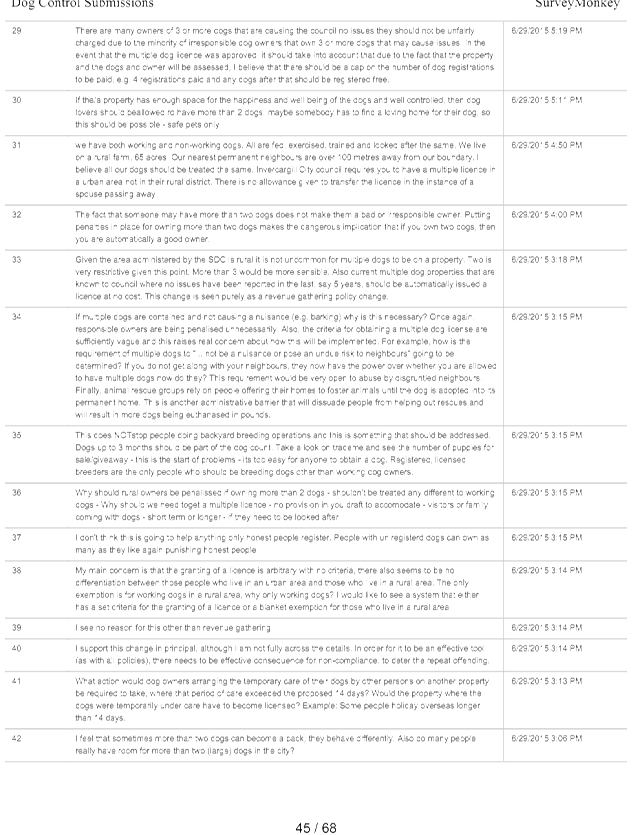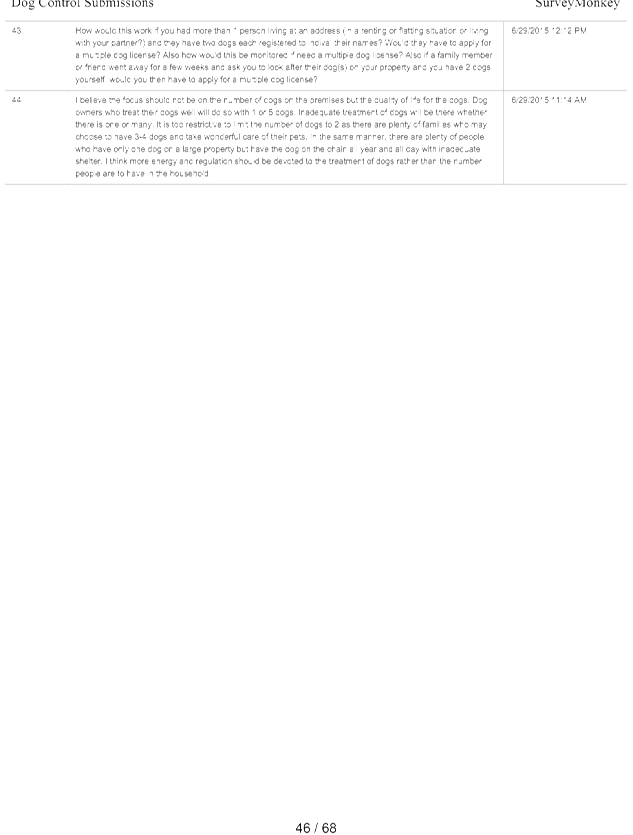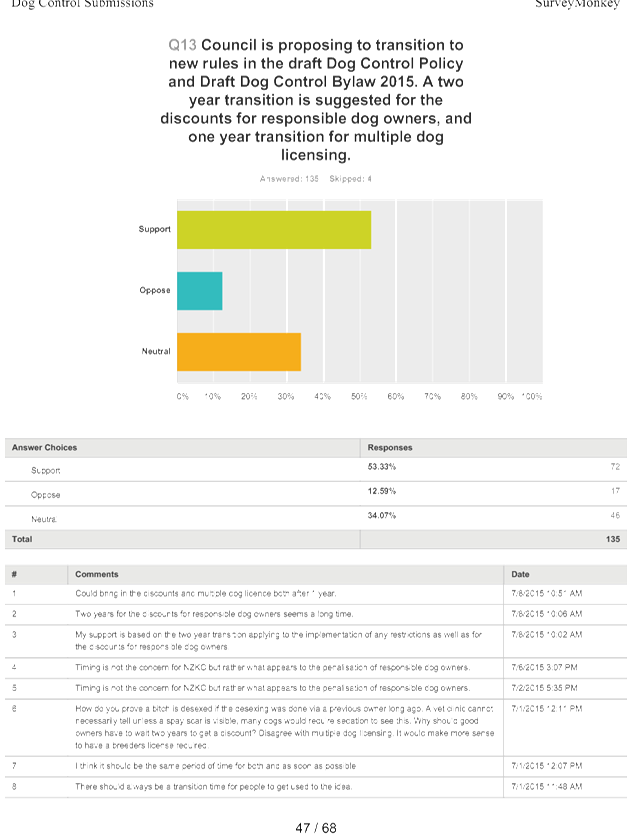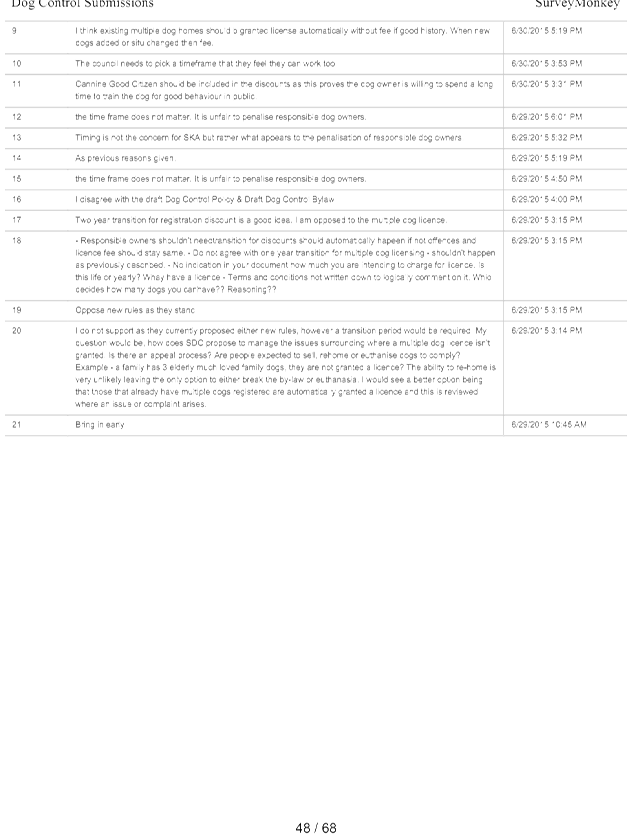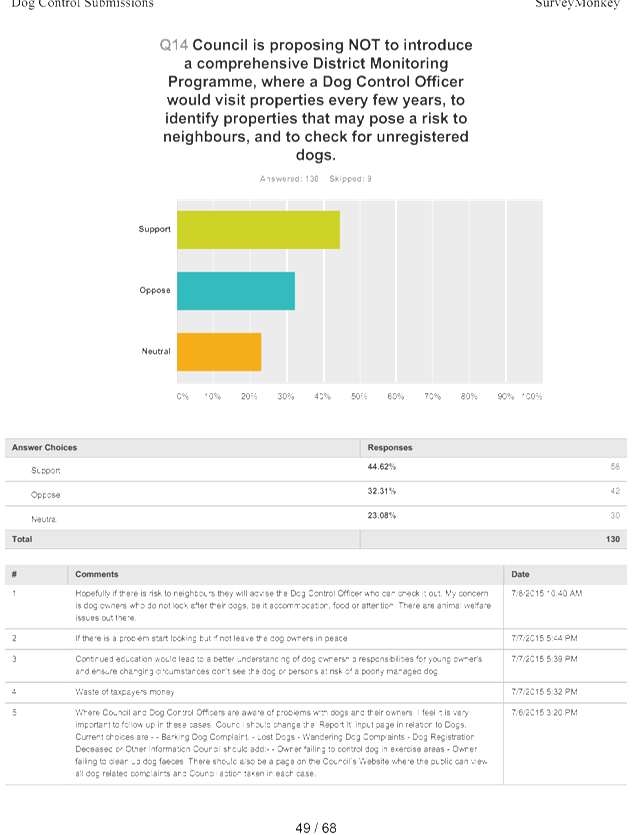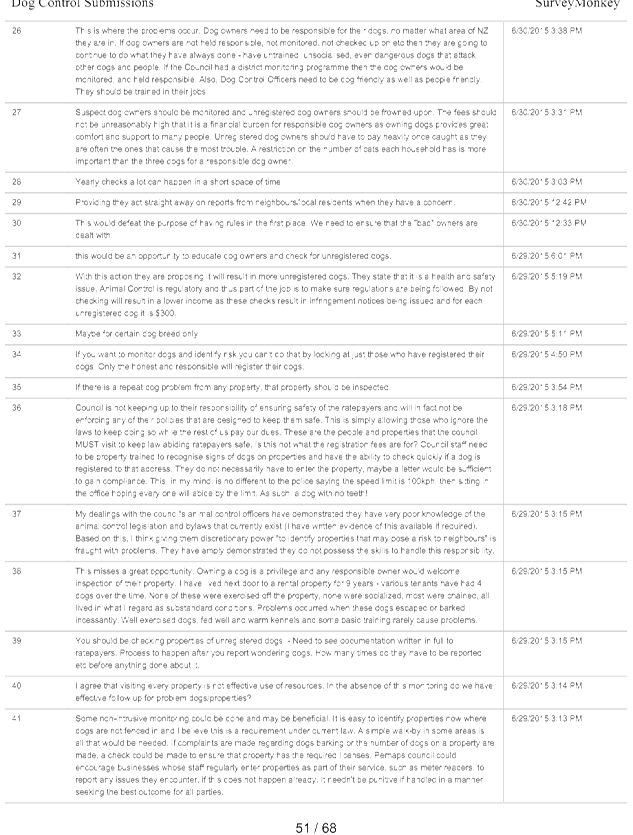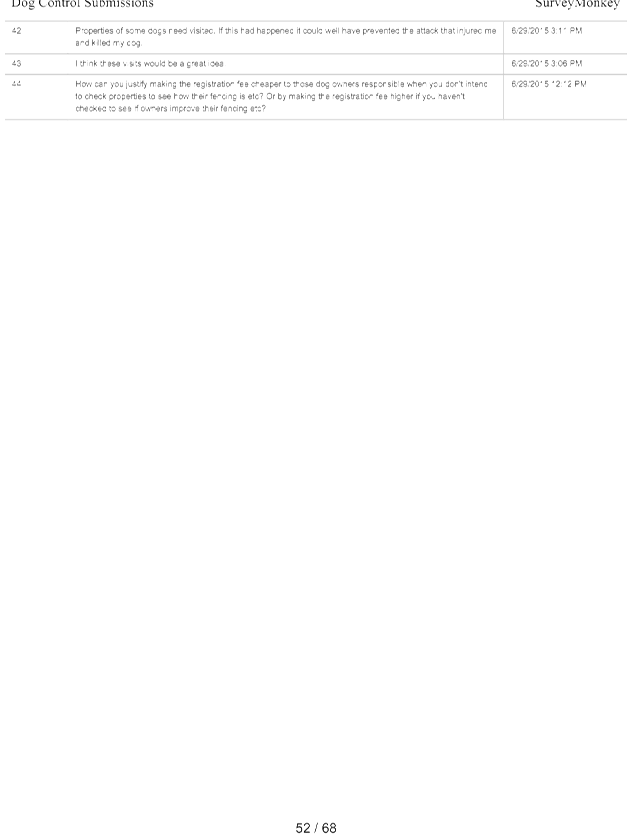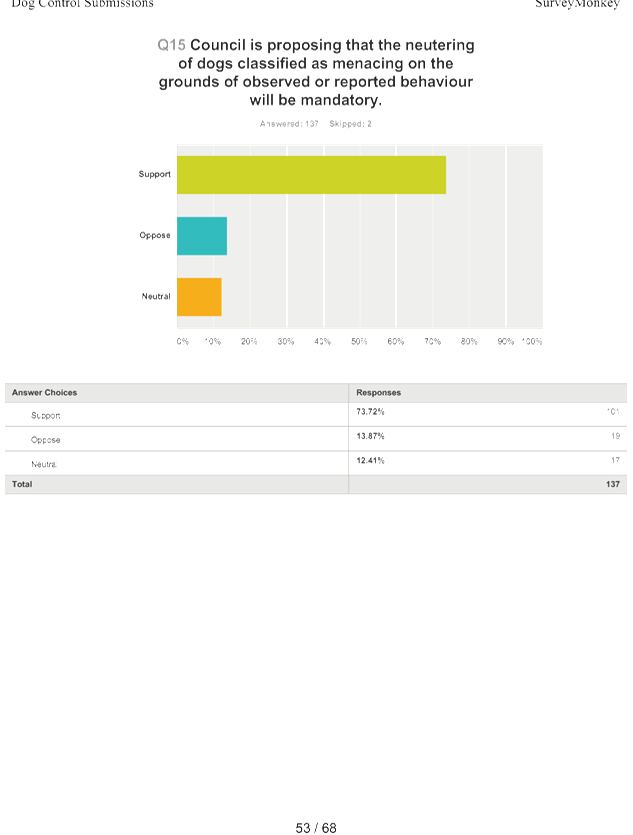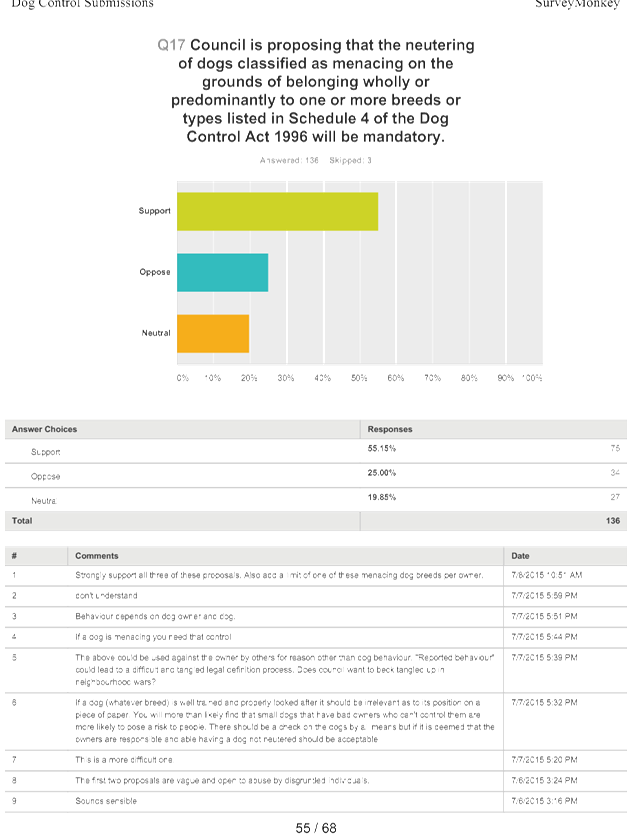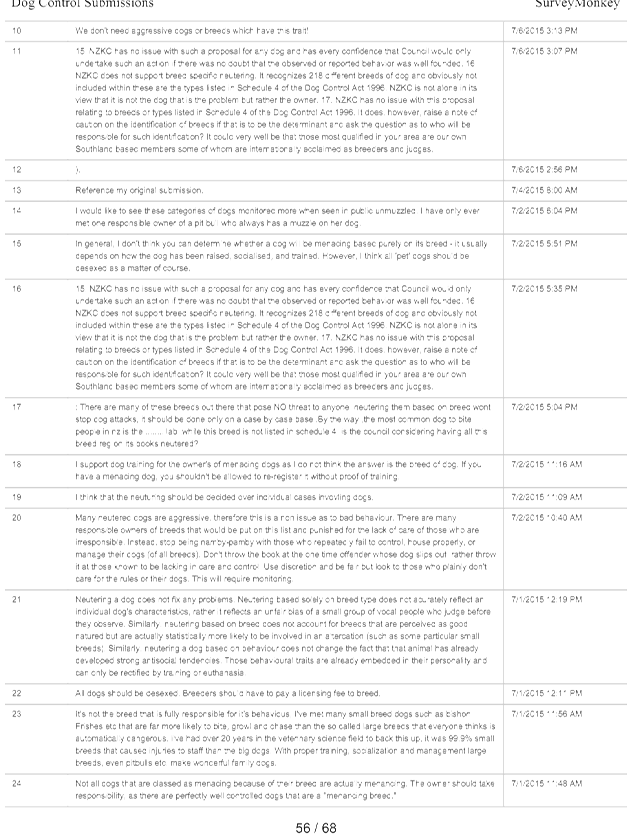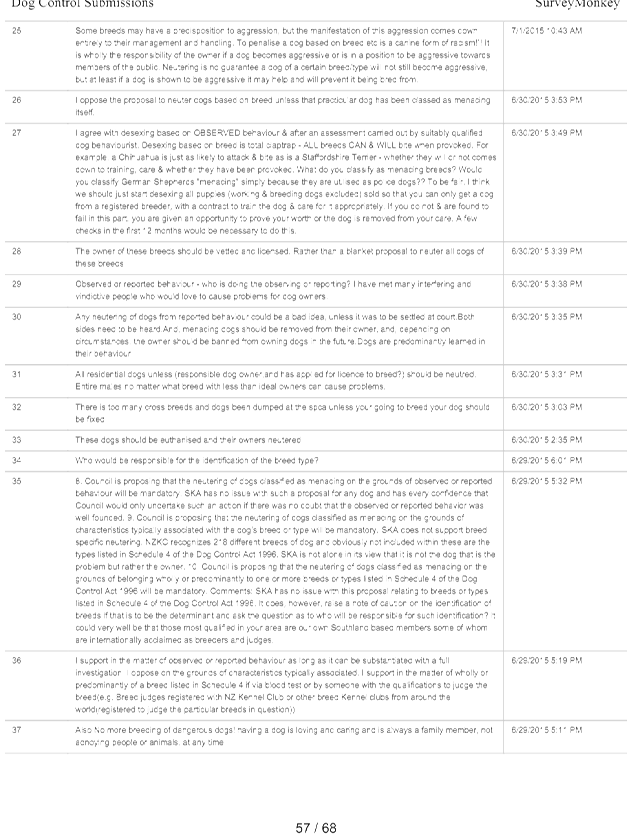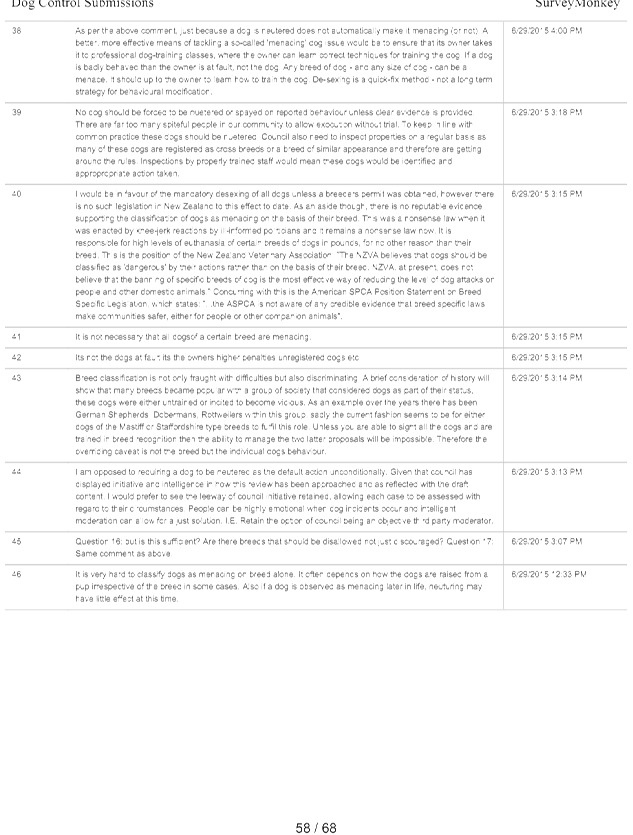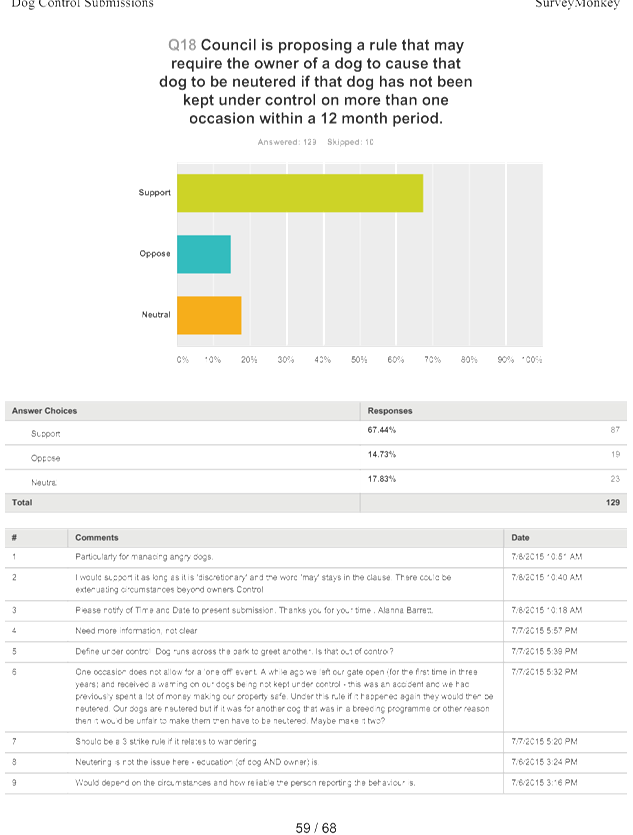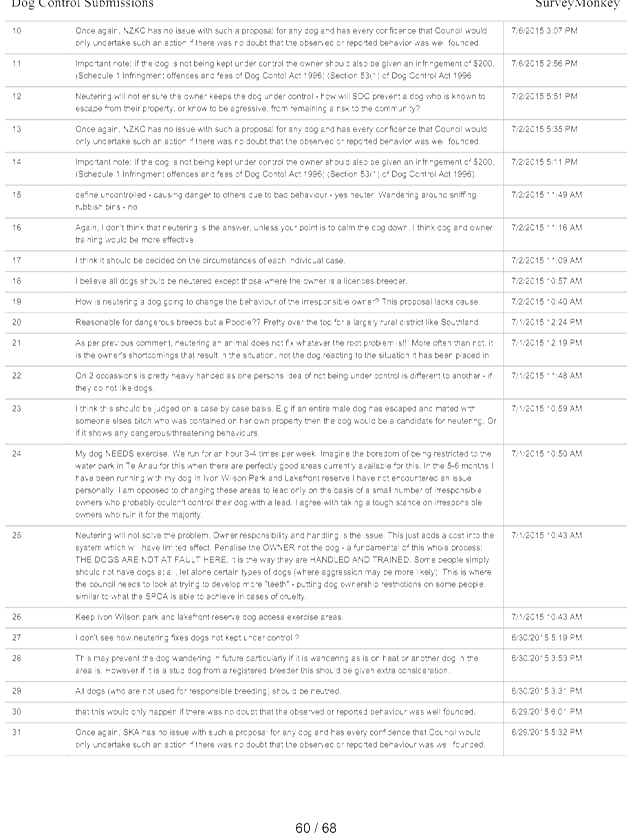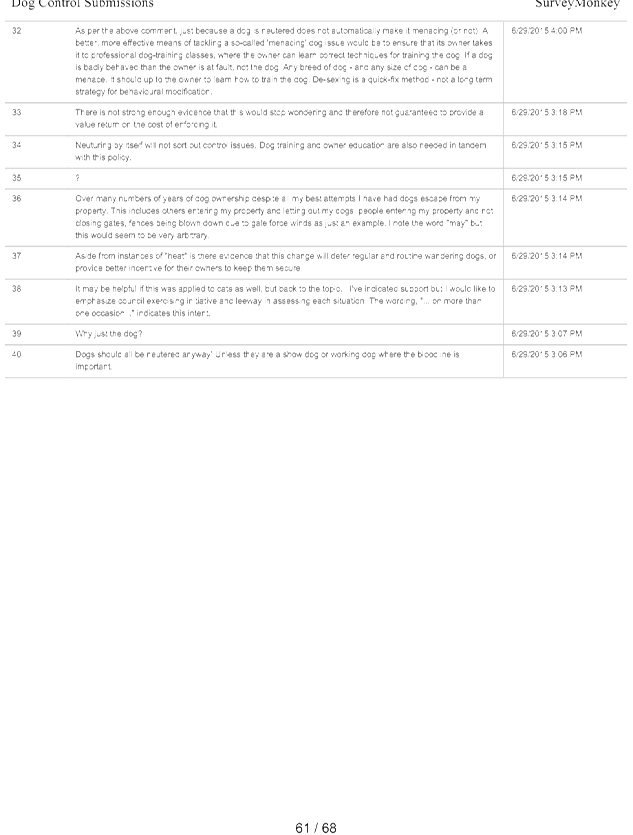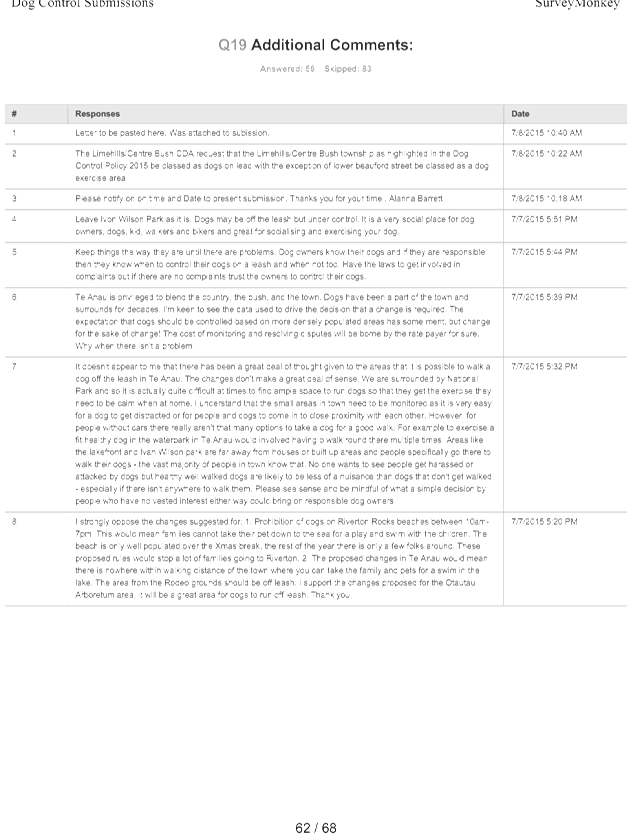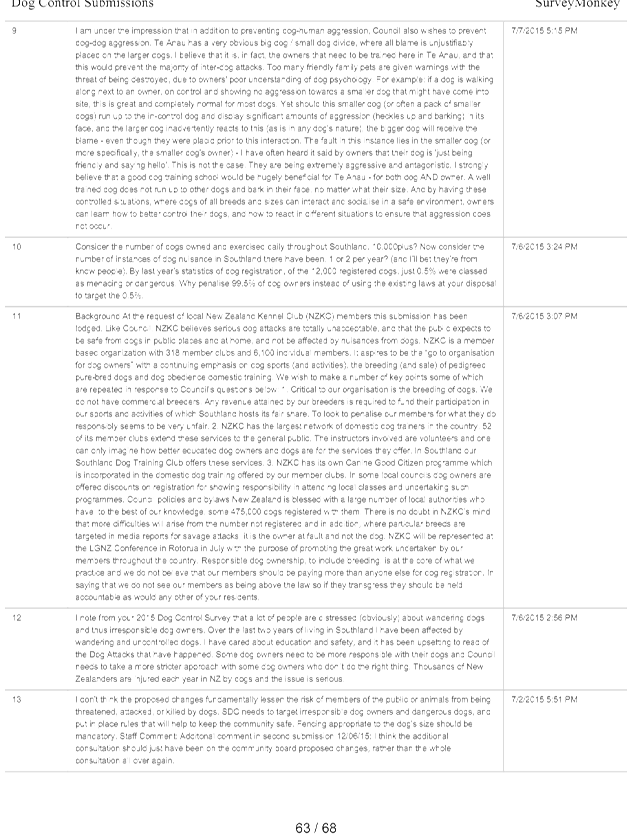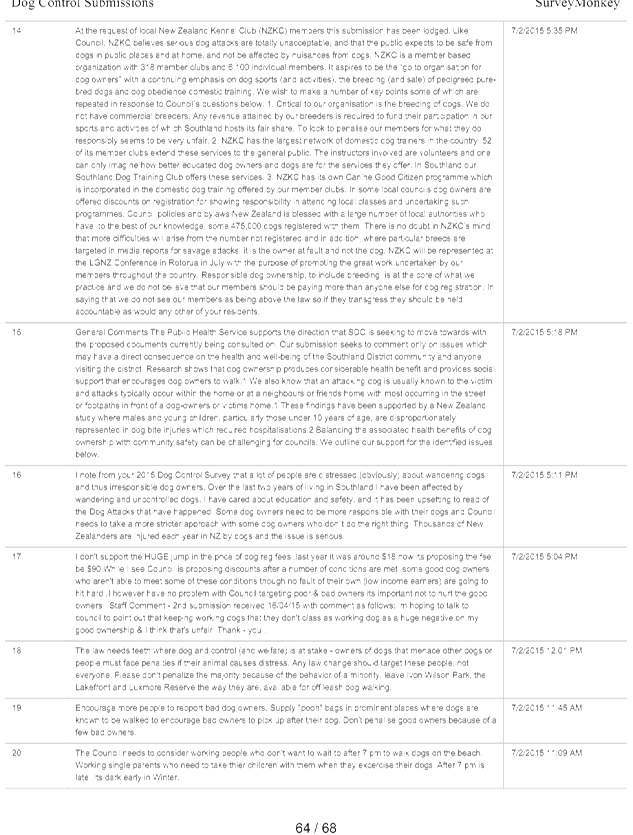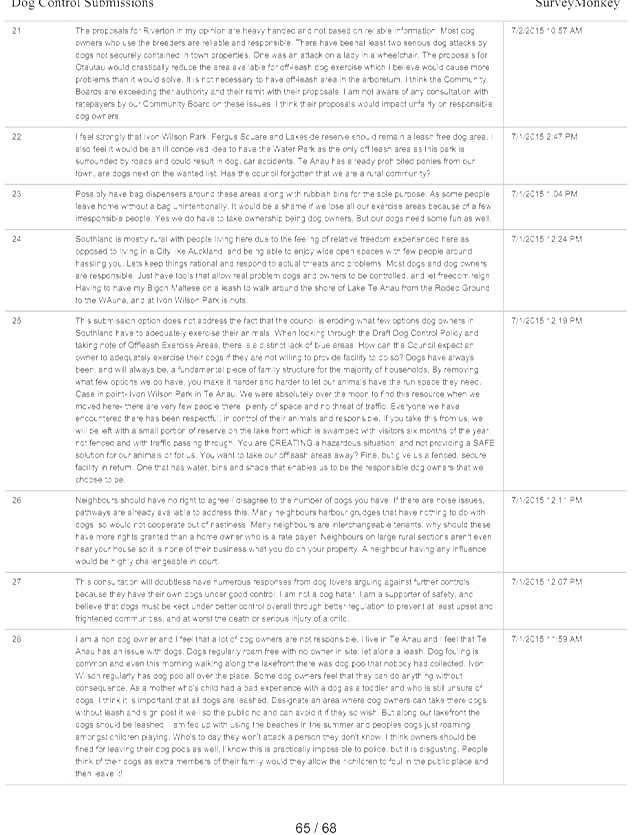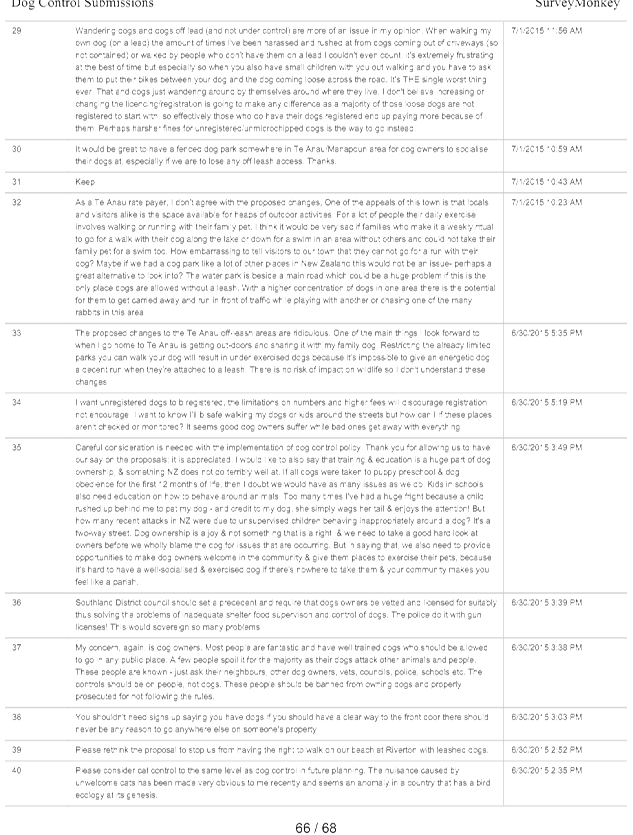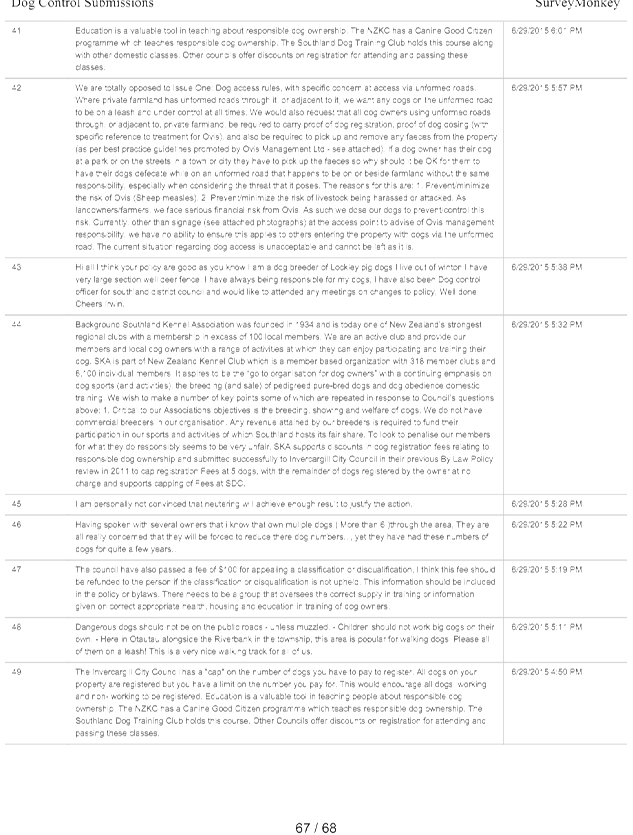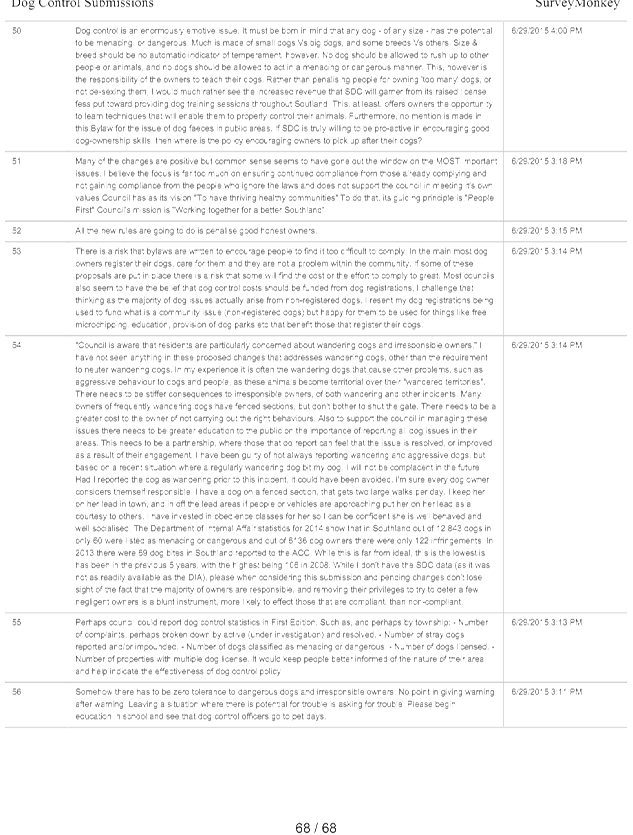
Notice is hereby given that an
Extraordinary Meeting of Southland District Council will be held on:
|
Date:
Time:
Meeting Room:
Venue:
|
Monday, 3
August 2015
9am
Council Chambers
15 Forth Street
Invercargill
|
|
Agenda to hear submissions on the
draft Dog Control Policy and Bylaw
OPEN
|
MEMBERSHIP
|
Mayor
|
Mayor Gary Tong
|
|
|
Deputy Mayor
|
Paul Duffy
|
|
|
Councillors
|
Lyall Bailey
|
|
|
|
Stuart Baird
|
|
|
|
Brian Dillon
|
|
|
|
Rodney Dobson
|
|
|
|
John Douglas
|
|
|
|
Bruce Ford
|
|
|
|
George Harpur
|
|
|
|
Julie Keast
|
|
|
|
Ebel Kremer
|
|
|
|
Gavin Macpherson
|
|
|
|
Neil Paterson
|
|
IN ATTENDANCE
|
Chief Executive
|
Steve Ruru
|
|
|
Committee Advisor
|
Fiona Dunlop
|
|
|
Extraordinary Council
03 August
2015
|

|
TABLE OF CONTENTS
ITEM PAGE
Procedural
1 Apologies 5
2 Leave of
absence 5
3 Conflict of
Interest 5
4 Public Forum 5
5 Extraordinary/Urgent
Items 5
Reports - Operational Matters
6.1 Dog
Control Policy 2015 and Dog Control Bylaw 2015 7
Public Excluded
Nil
|
Extraordinary Council
03 August
2015
|

|
1 Apologies
At the close of
the agenda no apologies had been received.
2 Leave
of absence
At the close of
the agenda no requests for leave of absence had been received.
3 Conflict
of Interest
Councillors are
reminded of the need to be vigilant to stand aside from decision-making when a
conflict arises between their role as a councillor and any private or other
external interest they might have.
4 Public Forum
Notification to speak
is required by 5pm at least two days before the meeting. Further information is
available on www.southlanddc.govt.nz
or phoning 0800 732 732.
5 Extraordinary/Urgent
Items
To consider, and if
thought fit, to pass a resolution to permit the Council to consider any further
items which do not appear on the Agenda of this meeting and/or the meeting to
be held with the public excluded.
Such resolution is
required to be made pursuant to Section 46A(7) of the Local Government Official
Information and Meetings Act 1987, and the Chairperson must advise:
(i) The
reason why the item was not on the Agenda, and
(ii) The reason why the
discussion of this item cannot be delayed until a subsequent meeting.
Section 46A(7A) of the Local Government Official Information and Meetings
Act 1987 (as amended) states:
“Where an item
is not on the agenda for a meeting,-
(a) That item
may be discussed at that meeting if-
(i)
That item is a minor matter relating
to the general business of the local authority; and
(ii)
the presiding member explains at the
beginning of the meeting, at a time when it is open to the public, that the
item will be discussed at the meeting; but
(b) no resolution,
decision or recommendation may be made in respect of that item except to refer
that item to a subsequent meeting of the local authority for further
discussion.”
|
Extraordinary
Council
3 August 2015
|

|
Dog Control
Policy 2015 and Dog Control Bylaw 2015
Record No: R/15/5/9008
Author: Michael
Sarfaiti, Environmental Health Manager
Approved by: Bruce
Halligan, GM - Environment and Community
☒
Decision ☐ Recommendation ☐ Information
Purpose
1 To hear
submissions on the Draft Dog Control Policy 2015 and Draft Dog Control Bylaw
2015 and to deliberate on those submissions.
Executive Summary
On 18 March 2015, Council adopted the draft Dog Control
Policy and Bylaw, and publicly notified and invited submissions on the proposal
closing at 5.00 pm on Thursday,
30 April 2015. Some Community Board submissions proposed significant
changes to the local dog access rules in the draft Statement of Proposal, and
as a result the consultation period was extended to 6 July 2015. A total of 136
submissions were received and of these, 30 submitters have asked to be
heard.
|
Recommendation
That the Council:
a) Receives
the report titled “Dog Control Policy 2015 and Dog Control Bylaw
2015” dated 21 July 2015.
b) Determines
that this matter or decision be recognised as not significant
in terms of Section 76 of the Local Government Act 2002.
c) Determines
that it has complied with the decision-making provisions of the Local
Government Act 2002 to the extent necessary in relation to this decision; and
in accordance with Section 79 of the Act determines that it does not require
further information, further assessment of options or further analysis of
costs and benefits or advantages and disadvantages prior to making a decision
on this matter.
d) Receives
the submissions on the proposed Dog Control Policy 2015 and
Dog Control Bylaw 2015.
e) Deliberates
on the draft Dog Control Policy 2015 and Draft Dog Control Bylaw 2015.
f) Instructs
staff to make any changes to the draft Dog Control Policy and
Dog Control Bylaw as required.
|
Content
Abbreviations and
definitions:
· The
Act: Dog
Control Act 1996.
· CB
and CDA: Community
Board and Community Development Area Subcommittee.
· Schedule
4 Dog: The breeds and type of dog subject to a ban on importation and
muzzling listed in Schedule 4 of the Act, being the American Pit Bull Terrier
type, and the breeds Brazilian Fila, Dogo Argentino, Japanese Tosa, and Perro
de Presa Canario.
Background
4 On 18 March
2015 Council adopted the draft Dog Control Policy and Bylaw, and publicly
notified and invited submissions on the proposal closing at 5.00 pm on
Thursday,
30 April 2015. Some Community Board submissions proposed significant changes
to the local dog access rules in the draft Statement of Proposal, and as a
result the consultation period was extended to 6 July 2015.
5 A booklet of
all submissions received is in Attachment C.
6 It is now
necessary to complete the process by considering the submissions received and
adopting the proposed policy and bylaw having regard to the submission
received.
7 The
proposed Dog Control Policy 2015 and Dog Control Bylaw 2015, that incorporate
staff recommendations as a result of the consultation process up to the time of
writing this report, is in Attachments A and B.
Issues
Issue 1 - Overall
submitter support for the new direction
8 Submitters
were overall supportive of the proposed new direction:
· Retention
of the default dog access rule that dogs may be off-leash but must be under
control at all times remains unchanged. This rule applies to public areas that
are not designated as prohibited, leash only or dog exercise areas (62% support
and 13% oppose).
· New
on-leash required rule for roadsides and footpaths (57% support and 32%
oppose).
· Introduction
of discounts into the registration fee (82% support and 10% oppose).
· Introduction
of multiple dogs licensing (61% support and 22% oppose).
· Transitional
arrangements (53% support and 13% oppose).
· Neutering
of classified menacing dogs on the grounds of observed behaviour
(74% support and 14% oppose).
· Neutering
of classified menacing dogs on the grounds of characteristics typically
associated with the dog’s breed or type (51% support and 33% oppose).
· Neutering
of classified menacing dogs on the grounds of belonging wholly or predominantly
to one or more breeds or types listed in Schedule 4 (55% support and 25%
oppose).
· New
rule that may require the owner of a dog to cause that dog to be neutered if
that dog has not been kept under control on more than one occasion within a 12
month period (67% support and 15% oppose).
9 A printout of
all responses with graphs is in Attachment D.
Issue 2 - Local
dog access rules
10 Many of the comments made
by submitters related to the proposed changes to the local dog access rules,
particularly in Riverton, Te Anau, and Winton.
11 A table of sample
submissions relating to the local dog access rules, and staff comments, is in Attachment
E.
12 In any community there
will be a number of people who want more dog control restrictions and others
who will want less. A number of dog owners have submitted that Council
should retain certain off-leash rules, but with the small sample sizes from each
community Council cannot statistically draw conclusions about overall community
feelings from these submissions and therefore changes based on these
submissions alone is not warranted.
13 Staff have been guided by
the CBs and CDAs who represent the views of their communities, and are
considered to be relatively neutral. During the extended period of the
consultative process, a number of CBs recommended amendments to the dog access
rules in the Statement of Proposal. These amendments have been incorporated
into the proposed policy and bylaw in Attachments A and B, and
are summarised here:
· Otautau
- whole of Arboretum to be on-leash only.
· Riverton
- Riverton Rocks beaches situated from the Coastguard Building to the
Navigation Light at the river mouth and from the Sound Shell to roads end at
Taramea (Howells Point) to be on-leash only.
· Te
Anau - Ivon Wilson Park to be undesignated (and therefore subject to the
default access rule of under control off-leash permitted).
· Winton
- delete ANZAC Oval as a dog exercise area, as this was a second preference
that the Community Board was seeking public feedback on.
Fiordland College
14 The Principal of
Fiordland College, Ms Lynlee Smith, has requested that the school grounds are
designated by Council as dogs prohibited. This has been incorporated into
the draft policy and bylaw.
New dog exercise areas
15 Some CDAs have
recommended new dog exercise areas in their townships, that were not included
in the Statement of Proposal. The CDAs have sought the approval of
adjacent landowners of all the new exercise areas, and Council’s
solicitor is satisfied that these changes do not warrant further consultation.
These have been incorporated into the proposed policy and bylaw.
16 The new exercise areas
are in Athol, Limehills/Centre Bush, Mossburn, and Waikaia.
Orepuki on-leash area
extensions
17 Orepuki CDA members
recommend extending the leash only areas at both the
Gemstone Beach carpark and the Monkey Island camping area on to the beach
adjacent to these two areas. The purpose is to maintain safety for the
many recreational users of these two beach areas. Members advise that
this rule should only apply to the beach area reasonably adjacent to both the
carpark and camping areas with the remainder of beach being off leash
permitted.
Issue 3 -
Submission from Federated Farmers of New Zealand
18 Staff agree with much of
the contents of the submission and the proposed policy and bylaw has been
updated accordingly.
19 The issues that have not
been accepted are (using the paragraph numbering in the submission):
· 2.6
- This is already a requirement in the Act (Section 52A).
· 2.22
- This is accepted, though Council should recognise that responsible owners of
non-working dogs also are low demand on Dog Control services.
· 2.33
- Clause 8.2 in the proposed policy expands on what Council will need to be
satisfied of when issuing a multiple dog licence. The details of the licensing
system do not legally need to be in the consultation documents.
· 3.3
- It is agreed that there is some subjectivity in the proposed welfare rules,
but this does not mean that they should not be in the bylaw. Having these
welfare rules in the bylaw makes the dog welfare expectations of Council clear,
and any action by an officer of Council concerning non-compliance with these
standards will need to be backed up with evidence.
· 3.10
- The Act requires dogs to be under control (or contained) at all times
everywhere. Note also that the default rule in the proposed bylaw is that
roads are on-leash required. The proposed rule by Federated Farmers is vague
and would be difficult to implement, and I believe the Act and the proposed
bylaw satisfactorily protect farmers from uncontrolled dogs.
· 3.19
- Refer to my comments in 2.33 above.
· 4.12
- The Council should recognise that responsible owners of non-working dogs also
are low demand users of Dog Control services, and the fee for each type should
be the same because of this.
The proportion of working dogs to non-working dogs is about
50:50 in the District.
It is recognised that working dogs are generally well trained
and controlled, and this is reflected in the proposed fees and charges, that do
not introduce discounts and sets a flat fee which is the same as the fully
discounted fee for non-working dogs.
There are concerns about working dogs. Comments were
raised in the public survey about the welfare of some working dogs such as
being kept in unsuitable accommodation, and staff would share that
concern. Also historically property visits by Dog Control Officers have
discovered unregistered dogs on farms including Schedule 4 dogs, and
non-working dogs being registered as working dogs.
As Council has recognised, so also the Government has
recognised in the tax system that working dogs are a tool of the trade, as
working dog owners can:
•
Claim 100% of the GST of
all working dog costs including registration.
•
Deduct the GST exclusive
cost of registration from their income tax return.
Any further discounting of working dog fees would result in
an equivalent increase in
non-working dog fees.
· 4.13
- This arrangement would mean that non-rural dog owners would have to pay more
to balance these proposed discounts. The comments in 4.12 above also
apply.
4.14 - This view misinterprets the funding model. The
purpose of Dog Control services are largely to protect the public, and Council
has resolved that dog owners are to fund this service (as opposed to the
ratepayer). Therefore the benefits to the dog owner in paying the
registration fee are the same as the benefits of any member of the public - the
protection from dogs.
Nevertheless there are some user-pay mechanisms, being
infringement fines and certain fees and charges.
· 4.17
- Responsible owners who are not in a rural area may object to Council showing
partiality to rural dog owners in having a separate fee structure. Also,
the categories of discounts all have application to rural non-working dogs.
Issue 4 -
Submissions from the New Zealand Kennel Club (NZKC) and members
20 The NZKC and a number of
members (locally of the Southland Kennel Association) have made
submissions. Members have some opposition to Council’s direction.
21 In my view, the NZKC has
not provided sufficient justification as to why Council should have different
rules for their members.
22 In particular:
· NZKC
members are a subset of the larger group of responsible owners.
· Responsible
owners who are not NZKC members may object to Council showing partiality to
members of a club, for example having a different fee structure for club
members. Many dog owners who are not members of the NZKC wish to breed their
dogs, or simply choose not to neuter their dogs, this is individual choice.
· Registration
costs can be recovered through the sale price of the dog.
23 Members also support the
capping of registration fees as Invercargill City Council has done, where a dog
owner pays fees for a maximum of say five dogs, regardless of the number of
dogs owned (the ICC multiple dog registration fee is $315). The keeping
of a larger number of dogs is a choice, and the costs of this choice has to be
considered and weighed up by the dog owner.
24 A car enthusiast who owns
a number of cars accepts that he/she has to pay multiple vehicle registration
fees. Ultimately such a cap would mean that dog owners with less than
five dogs would have to pay more to balance those who have more than five dogs.
Issue 5 -
Effect of the irresponsible minority
25 A
number of submitters commented that they felt responsible owners are being
punished because of the actions of an irresponsible minority. This is a
common thread of concern in regulatory issues that Council has come across
recently, e.g. the introduction of the sinking lid gambling policy, the new
local alcohol policy, and also the freedom camping survey.
26 There
is a need to protect the public from irresponsible people, and this includes
protection from harm and also reducing the costs on tax/ratepayers associated
with irresponsibility. A balance is therefore required between the
extremes of total prohibition and total freedom, and the views of the public
will follow a bell curve (of sorts) with regard to these extremes in all these
issues.
Issue 6 -
The effectiveness of education
27 A number of submitters
commented that education is the answer, not more regulation.
With any regulatory issue education plays an important role; and rules,
monitoring, incentives/penalties, and enforcement are also essential components
of any regulatory authority that wishes to protect the public from the harmful
effects from an activity. The reason for this is explained in Issue 5
above.
Issue 7 -
Recognition of the NZKC Canine Good Citizen National Certification programme
28 Some
submitters suggest that a further discount should be added for holders of a
NZKC Canine Good Citizen certificate.
29 The proposed fee
discounts do recognise responsible ownership, with discounts for containment,
microchipping and good behaviour (and de-sexing).
30 There
are a number of other matters that could be incentivised in the proposed
discounts, such as:
· Secure
access to a door of the house.
· Breed/weight
discounts.
· Avian
awareness and avoidance training (especially relevant to dogs on
Stewart Island).
· Puppy
Preschool training.
31 All
of the above would have support from some members of the public.
32 Problems with adding more
incentives are:
· How
far do you go, or what are reasonable expectations to place on our dog owners.
· The
large group of responsible owners that do not qualify for such discounts end up
subsidising those who do, and both groups control their dogs well.
· The
cost/time burden on dog owners to achieve some of these discounts, such as a
course of training or new fencing.
33 Overall
submitters were supportive of the proposed discounts, as were the general
public in Council’s recent dog control survey.
Factors to Consider
Legal and Statutory
Requirements
34 When deliberating,
Section 10(4) of the Act requires of Council:
“In
adopting a policy under this section, the territorial authority must have
regard to—
(a) the
need to minimise danger, distress, and nuisance to the community generally; and
(b)
the need to avoid the inherent danger in
allowing dogs to have uncontrolled access to public places that are frequented
by children, whether or not the children are accompanied by adults; and
(c)
the importance of enabling, to the extent
that is practicable, the public (including families) to use streets
and public amenities without fear of attack or intimidation by dogs; and
(d) the
exercise and recreational needs of dogs and their owners.”
Community
Views
35 Council conducted a
public survey prior to drafting the policy and bylaw. The drafts were
subject to the special consultative procedure, and the author also consulted
with CBs and CDAs.
36 From
the Department of Internal Affairs:
“The development of a Council’s dog policy is
an opportunity to discuss and debate dog control issues with the community
(including both dog owners and non-dog owners). It will confirm the
mandate or level of support for the Council’s approach”.
Costs
and Funding
37 The new and expanded
services, and licensing systems, will add to the costs of the
Dog Control business unit. The new fees proposed will add to the cost of
dog ownership.
38 Council
has already resolved that Dog Control is to be funded fully from registration
fees, infringement fines, and other user charges.
Policy
Implications
39 The proposed Dog Control
Policy 2015 will replace Council’s current Dog Control Policy.
Analysis
Options Considered
40 The options are
whether to hear the submissions on the draft Dog Control Policy 2015 and draft
Dog Control Bylaw 2015 and to continue, or to hear the submissions and
decide to stop the process.
Analysis of Options
41 Option
1 - To hear the submissions on the draft Dog Control Policy 2015 and
draft Dog Control Bylaw 2015 and to continue
|
Advantages
|
Disadvantages
|
|
· The
new policy and bylaw will reflect community expectations, which are not
currently met in the existing policy and bylaw.
· Recent
publicity of dog attacks has raised awareness of the terror of dog attacks;
and the new policy and bylaw are an effective response to these
concerns.
· Expected
to result in the reduced incidence of wandering and dog aggression in the
District, less unwanted dogs, and less Schedule 4 dogs.
|
· Negative
feedback from both dog owners and non-dog owners.
Dog control is an emotive, polarising community issue.
· Costs
of implementation.
|
42 Option
2 - To hear the submissions and stop the process
|
Advantages
|
Disadvantages
|
|
· A
review is legally not required.
|
· Existing
Dog Control Policy 2010 and draft Dog Control Bylaw 2010 do not meet
current community expectations.
|
Assessment of Significance
43 This
review is considered to be not significant in accordance with Council’s
Significance and Engagement Policy.
Recommended Option
44 To hear the
submissions and to continue with the process.
Next Steps
45 Council will make
recommendations on the draft Dog Control Bylaw 2015 and draft Dog Control
Policy 2015 and will make a final decision on 26 August.
Attachments
a Southland
District Council Policy on Dogs 2015 View
b Southland
District Council Bylaw 2015 View
c Submissions
Booklet View
d Dog
Control Submissions Summary Data View
e Sample
submissions on dog access rules and staff comments View

1. INTRODUCTION
1.1 The
Council recognises that the keeping of dogs is a positive part of the life of
many Southlanders. Whether as working dogs or companions, dogs under
responsible ownership can have a positive role in society and provide
assistance, enjoyment and health benefits to many individuals and families.
1.2 The
Council is also mindful of the need to minimise the adverse impacts dogs can
have on communities.
The
Dog Control Act 1996 (the Act) requires that the Council have a dog control
policy in its district. In adopting the policy the Council must have regard to.
(a) The
need to minimise danger, distress, and nuisance to the community generally; and
(b) The
need to avoid the inherent danger in allowing dogs to have uncontrolled access
to public places that are frequented by children, whether or not the children
are accompanied by adults; and
(c) The
importance of enabling, to the extent that is practicable, the public
(including families) to use streets and public amenities without fear of attack
or intimidation by dogs; and
(d) The
exercise and recreational needs of dogs and their owners.
1.3 The
intention of this policy is to strike the proper balance between the need to
control dogs and the recognition of the overall benefits of responsible dog
ownership.
1.4 Any
word used in this policy document that is defined in the Act has the meaning
given to it by that Act.
2. OBJECTIVE
The Council’s objective is to
encourage responsible dog ownership that allows dog owners to enjoy their dogs
without impinging on the enjoyment and safety of others. Responsible dog
owners will:
(a) Register and
microchip their dogs.
(b) Ensure that the
dogs always wear a current registration tag.
(c) Provide their dogs
with sufficient food, water, shelter and exercise.
(d) Make
sure that their dogs do not become a nuisance or danger to people or animals.
(e) Comply with the Dog
Control Act 1996 and the Council’s Dog Control Bylaws.
3. DOG CONTROL
BYLAWS
3.1 The
Council must have bylaws to give effect to its Dog Control Policy. It is
intended that the Dog Control Bylaw 2015 be enacted to reflect the contents of
this policy document.
3.2 The
Act specifies matters for which bylaws may be made. The bylaws apply to
all dog owners in the District and will be enforced using the full range of
enforcement mechanisms available to the Council.
3.3 The
following issues have been identified which will be dealt with by the bylaws:
(a) Minimum
standards of accommodation for dogs.
(b) Prohibiting
dogs from specified public places.
(c) Regulating
and controlling dogs in other public places.
(d) Requiring
the removal of dog faeces from public places.
(e) Prohibiting
female dogs in season and diseased dogs from public places unless confined or
permission granted.
(f) Regulating
the number of dogs that may be kept on any premises.
(g) Requiring
the neutering of uncontrolled and menacing dogs.
4. DOGS IN PUBLIC
PLACES
4.1 This
policy identifies public places in the Southland District where dogs are
prohibited or must be controlled on a leash. It also designates dog
exercise areas where dogs may be exercised off the leash, provided they are
under control.
4.2 No person may
take a dog (not including a dog confined in a vehicle or cage) into any public
place specified in Schedule 1 or 2 as prohibited unless –
(i) any
working dog while it is under the control of its owner or handler; or
(ii) a
public place not under the control of the Council where the person in charge of
that place has given permission for the dog to be there and the presence of the
dog is in accordance with the conditions (if any) of that permission.
4.3 No person shall take any female dog in season or a diseased dog into
any public place unless –
(i) that
dog is completely confined in a vehicle or cage for the purposes of
transportation; or
(ii) the
occupier or person controlling the public place has given permission for the
entry or presence of the dog.
4.4 No person shall
take a dog into any public place specified in Schedule 1 or 2 as an on-leash
only area unless the dog is controlled on a leash unless –
(i) any
dog confined in a vehicle or cage; or
(ii) any
working dog while it is under the control of its owner or handler.
4.5 The owner of any dog (including a dog classified as a
menacing or dangerous dog that is muzzled) may take that dog in any public
place specified in Schedules 1 or 2 as a designated dog exercise area provided
that dog is kept under control.
4.6 Except as
provided for in Schedules 1 and 2, dogs must be under control at all times and
may be off a leash.
4.7 The Council may
from time to time by public notice prohibit or impose additional conditions on
the taking of dogs to any of the areas in Schedules 1 and 2 or walking tracks
and picnic areas under the control of the Council and those conditions shall
apply accordingly as if they are conditions specified in the Schedules.
The Council may from time to time by public notice make temporary
changes to Schedules 1 and 2 in relation to leisure and culture events
(including dog friendly events), dog training, threatened or ‘at
risk’ protected wildlife vulnerable to dogs, and pest control. Those
changes shall apply as if they are conditions specified in the Schedules.
In this clause, public notice means one or more clearly legible
notices affixed in one or more conspicuous places on, or adjacent to, the area
to which the notice relates.
4.8 The
Fiordland and Rakiura National Parks are within the Southland District.
The Parks comprise large areas of Fiordland and Stewart Island respectively.
The boundaries of both parks can be ascertained by referring to the maps on the
website of the Department of Conservation at www.doc.govt.nz.
Dogs are not allowed to be in
national parks and the National Parks Act 1980 makes it an offence for any
owner or person in charge of a dog to have it in a national park except in the
circumstances and subject to the conditions specified in that Act.
There are some exceptions to the
general rule prohibiting dogs from being in a National Park. For example,
in the context of Fiordland National Park, there are small areas at Supply Bay,
Frasers Beach, Upper Waiau River, Ewe Burn and
Te Anau Downs where access by dogs may be available by a permit issued by the
Department of Conservation. All inquiries about the extent of permitted
dog access in both National Parks should be made to the Department of
Conservation offices at Invercargill, Te Anau or Oban.
4.9 In
addition to the two National Parks there are areas of conservation land in the
Southland District administered by the Department of Conservation where access
by dogs is controlled (by permit issued by the Department) or open (under
control everywhere and on a leash in any camping areas and at hut sites).
The Department of Conservation has
published a map on its website www.doc.govt.nz showing the boundaries of
the open and controlled access areas.
It is important that a person
considering taking a dog on to any conservation land first make inquiries of
the Department of Conservation about the permit and control requirements.
5. REGISTRATION
AND OTHER FEES
5.1 The
Council has adopted a registration fee structure which recognises non-working
dogs and working dogs.
5.2 As
recognition of responsible dog ownership and to encourage neutering and fenced
containment, the Council will set fees for non-working dogs that may take into
account the following factors:
• Whether
there is fencing or a fenced enclosure sufficient to contain the dog on the
premises.
• Whether
the dog is neutered or spayed.
• Whether
there has been a written warning, barking abatement notice, seizure or
infringement under the Dog Control Act 1996 within the previous two years
relating to any dog owned by the person applying for the registration.
• Whether
the dog has been microchipped.
• A
fee for late registration.
5.3 The
Dog Control Act 1996 requires that all money received from dog registration
fees or other charges levied are to be applied for dog control purposes.
The intention of Council is that dog control in the District is on a user pay
basis of fees and charges will be set at a level to give effect to that
intention.
6. BARKING
DOGS
6.1 Section
55 of the Dog Control Act 1996 authorises Council’s Dog Control Officers
to issue an abatement notice to any person who owns a dog which the Officer
considers is causing a nuisance by persistent and loud barking or
howling.
Non-compliance with this notice will result in enforcement action.
6.2 Section
56 authorises the Officer to remove the dog from the premises if the owner
takes no action, or the nuisance is continuing and causing distress to any
person.
6.3 The
Council will implement these provisions on substantiated complaint.
7. MENACING
AND DANGEROUS DOGS
7.1 The
Dog Control Act 1996 contains provisions which enable the Council to require
specific control action be taken in respect of menacing or dangerous dogs.
7.2 A
menacing dog is one that has not been classified as dangerous but which the
Council considers may pose a threat to people, stock, poultry, domestic animal
or protected wildlife because of any observed or reported behaviour of the dog,
or any characteristics typically associated with the dog’s breed or type,
or belongs wholly or predominantly to one or more breeds or types listed in
Schedule 4 of the Dog Control Act 1996.
7.3 A
dangerous dog is one which the Council has on sworn evidence attesting to the
aggressive behaviour by the dog, reasonable grounds to believe that it
constitutes a threat to the safety of any person, stock, poultry, domestic
animal or protected wildlife or where the owner has admitted in writing that
the dog constitutes such a threat or has been convicted of an offence relating
to the dog attacking a person or animal.
7.4 The
Council:
• Will
enforce all of the provisions of the Dog Control Act 1996 relating to dangerous
and menacing dogs.
• Require
all dogs classified as menacing by the Council or any other Council to be
neutered and the owner provide a veterinary certificate showing the dog has
been neutered within one month of classification.
8. NUMBER OF DOGS
8.1 No
more than two dogs can be kept on any premises without a multiple dog licence.
This requirement does not apply to:
• Dogs
up to three months old.
• Working
dogs kept on a premises that is not in an urban area where the numbers are
reasonably necessary for carrying out the function for which they have been
trained.
• Any
dogs kept on premises over 50 hectares.
• Dogs
kept temporarily on veterinary clinic premises.
• A
pound established under Section 67 of the Dog Control Act 1996.
8.2 The Council will issue multiple
dog licences only when it is satisfied that:
• The
premises concerned is suitable in all respects for the keeping of the number of
dogs applied for.
• The
arrangements relating to the feeding shelter and exercise of the dogs are
adequate.
• The
keeping of the number of dogs applied for will not be a nuisance or pose an
undue risk to neighbours.
8.3 A
licence issued may impose any conditions that Council officers consider are
reasonably necessary taking into account the matters referred to in paragraph
8.2.
8.4 A multiple dog licence will not
be transferable.
8.5 A fee will be charged for the
issue and administration of a multiple dog licence.
9. ENFORCEMENT
9.1 The
Council will use the full range of enforcement options available to it under
the Dog Control Act 1996 and other legislation to ensure that dog ownership in
the District is undertaken in accordance with this policy.
9.2 The
Dog Control Act 1996 provides that the Council may issue infringement notices
or prosecute for, offences against the act or the Council’s bylaws.
The Council’s aim is to
promote responsible dog ownership and therefore an educational advisory
approach will be taken where appropriate.
However, enforcement action may be taken without warning where:
• An
owner fails to register a dog.
• The
actions or inaction of the owner amount to a disregard to the safety or
convenience of any person or the safety of any animal.
• The
dog has attacked a person or animal.
• There
has been a deliberate attempt to circumvent the Dog Control Act 1996 or the
Council bylaws.
9.3 Dogs
found at large in a public place in contravention of the Council’s bylaws
may be seized and impounded by a Dog Control Officer, Dog Ranger, or any other
person authorised by the Council.
SCHEDULE 1
General
Dog Access Rules
This
Schedule contains general dog access rules that apply across the Southland
District.
1. Playgrounds
and sports grounds under the control of the Council
Dogs
are prohibited on any playground or sports ground at all times.
2. Urban
zones, roads, Council-controlled carparks and boating areas, designated freedom
camping areas
Dogs must be under control and on a leash within or on all
–
(a) Urban
zones as identified in the Southland District Plan; and
(b) Roads
as defined in the Dog Control Bylaw 2015; and
(c) Council-controlled
car parks; and
(d) Council-controlled
boating areas (including any wharf, jetty, boat ramp, boat marshalling area);
(e) Designated
freedom camping areas as defined in Council’s Camping Control Bylaw 2012.
3. Council
cemeteries, Council camping grounds
Dogs
are prohibited from all Council-controlled cemeteries and camping grounds
unless permission is obtained from the Council or signage indicates dogs
are allowed and provided the person whom the dog is accompanying complies with
any reasonable conditions imposed by the Council in relation to the entry or
presence of the dog.
4. Walking
tracks and picnic areas under the control of the Council
Every
owner must comply with any restriction or prohibition of a sign to which
Clause 4.7 applies.
Note: For convenience, playgrounds and the Urban Zones are shown on the maps in
Schedule 2. For technical reasons other areas that are referred to above
cannot be shown.

SOUTHLAND DISTRICT COUNCIL
DOG CONTROL
BYLAW 2015
Pursuant to the Local Government Act 2002 and the Dog
Control Act 1996, the Council makes the following bylaw:
PART 1
PRELIMINARY
PROVISIONS
1. TITLE
AND COMMENCEMENT
This
bylaw may be cited as the Dog Control Bylaw 2015 and shall come into force on
the 8th day of August 2015.
2. REPEAL
The
Southland District Council Dog Control Bylaw 2010 is repealed.
3.
APPLICATION
Except
as otherwise provided this bylaw applies to the whole of the district of the
Council.
4.
INTERPRETATION
(a) In
this bylaw, unless the context otherwise requires:
“The
Act” means the Dog Control Act 1996.
“Council”
means the Southland District Council or any person delegated by it to act
on its behalf.
“Premises”
means any land, dwelling, storehouse, warehouse, shop, cellar, yard,
building, or part of the same, or enclosed space separately occupied, and all
lands, buildings, and places adjoining each other and occupied together are
deemed to be the same premises.
“Road”
means that area of a road defined in the Local Government Act 1974 that is
used or is reasonably usable for vehicular or pedestrian traffic and includes
the margins of that area.
“Urban
Zone” means those areas defined as urban zones in the Southland
District Plan planning maps.
(b) Any
term not defined in this bylaw but which is defined in the Act shall have the
meaning given to it by the Act.
PART 2
REGULATION,
CONTROL, AND ACCOMMODATION OF DOGS
5. MINIMUM
STANDARDS OF ACCOMMODATION FOR DOGS
(a) Every
owner shall ensure that:
(i) dogs
are provided with sheltered and dry sleeping quarters with access to clean
water; and
(ii) measures
are taken to enable dogs to keep warm in cold weather; and
(iii) sleeping
quarters are large enough to allow the dog to stand up, turn around and lie
down comfortably; and
(iv) dogs
are able to urinate and defecate away from the sleeping area; and
(v) ventilation
and shade is provided in situations where dogs are likely to experience heat
distress; and
(vi) the
shelter is kept in a sanitary condition.
6. CONTROL
OF DOGS IN PUBLIC PLACES
(a) Except
in the areas specified in Schedules 1 and 2 or otherwise required by the Act
dogs in public places may be off-leash but must be under control at all times.
7. CONTROL
OF DOGS IN DESIGNATED DOG EXERCISE AREAS
(a)
The owner of any dog (including a dog
classified as a menacing or dangerous dog that is muzzled) may take that dog
off-leash in any public place specified in Schedules 1 or 2 as a designated dog
exercise area provided that dog is under control at all times.
8. CONTROL
OF DOGS IN PUBLIC PLACES SPECIFIED AS ON- LEASH AREAS
(a) No
person shall take a dog into any public place specified in Schedule 1 or 2 as
an on-leash only area unless the dog is controlled on a leash.
(b) Clause 8(a) does not apply
to –
(i) any
dog confined in a vehicle or cage; or
(ii) any working dog while it
is under the control of its owner or handler.
9. PROHIBITION
OF DOGS IN CERTAIN PUBLIC PLACES
(a) No person may take a dog
not confined in a vehicle or cage into any public place specified in Schedule 1
or 2 as a prohibited area.
(b) Clause 9(a) does not apply
to:
(i) any
working dog while it is under the control of its owner or handler.
(ii) a
public place not under the control of the Council where the person in charge of
that place has given permission for the dog to be there and the presence of the
dog is in accordance with the conditions (if any) of that permission.
(c) No
person shall take any female dog in season or a diseased dog into any public
place unless –
(i) it
is completely confined in a vehicle or cage for the purposes of transportation;
or
(ii) the occupier or person
controlling the public place has given permission for the entry or presence of
the dog.
10. CHANGES TO DOG
ACCESS AREAS BY PUBLIC NOTICE
(a) The
Council may from time to time by public notice prohibit or impose additional
conditions on the taking of dogs to any of the areas in
Schedules 1 and 2 or walking tracks and picnic areas under the control of the
Council and those conditions shall apply accordingly as if they are conditions
specified in the Schedules.
(b) The
Council may from time to time by public notice make temporary changes to
Schedules 1 and 2 in relation to leisure and culture events (including dog
friendly events), dog training, threatened or ‘at risk’ protected
wildlife vulnerable to dogs, and pest control. Those changes shall apply as if
they are conditions specified in the Schedules.
(c) In
this clause, public notice means one or more clearly legible notices affixed in
one or more conspicuous places on, or adjacent to, the area to which the notice
relates.
11. DOG FAECES
(a) The
person in charge of any dog that defecates in any public place must immediately
remove and dispose of the faeces in a way that does not cause a nuisance.
(b) Clause
11(a) does not apply to any working dogs herding or driving stock on a road.
12. MULTIPLE DOGS
ON PREMISES
(a) Except
as provided in clause 12(b), no person may keep more than two dogs over three
months of age (other than working dogs) on any premises for more than 14
consecutive days.
(b) Subclause
(a) does not apply if –
(i) allowed
by a licence issued under clause 13; or
(ii) an
application for a licence under clause 13 has been made within 14 days of
there being more than two dogs kept on those premises; or
(iii) the
premises are over 50 hectares.
(iv) the
premises comprise a veterinary practice or a Council pound.
13. LICENCE
FOR MULTIPLE DOGS ON PREMISES
The
Council may grant a licence to keep more than two dogs on premises on such
terms as it considers are reasonably necessary.
14. REQUIREMENT
TO NEUTER UNCONTROLLED DOG
The
Council may require the owner of a dog to cause that dog to be neutered if that
dog has not been kept under control on more than one occasion within a 12 month
period.
15. EFFECT
OF REQUIREMENT TO NEUTER UNCONTROLLED DOG
(a) If a dog is required to be
neutered, the owner of that dog must, within one month after receipt of
the notice of the requirement, produce to the Council a certificate issued by a
veterinarian certifying –
(i) that
the dog is neutered; or
(ii) that
for reasons that are specified in the certificate, the dog will not be in a fit
condition to be neutered before a date specified in the certificate; and
(iii) must,
if a certificate under subclause (a)(ii) is produced to the Council, produce to
the Council, within 1 month after the date specified in that certificate, a
further certificate under subclause (a)(i).
PART 3
IMPOUNDING,
OFFENCES AND PENALTIES
16.
IMPOUNDING
(a) A
dog control officer or a dog ranger may impound any dog at large in breach of
this bylaw, whether or not the dog is wearing a collar having the proper label
or disc attached indicating that the dog is currently registered.
17.
OFFENCES AND PENALTIES
(a) Every person who breaches
this bylaw commits an offence is liable to the penalty specified in the Local
Government Act 2002.
PART 4
TRANSITIONAL
PROVISIONS
18. EXISTING
DOG OWNERS WITH MORE THAN TWO DOGS
Any
dog owner who has more than two dogs on any premises at the commencement of
this bylaw is not required to obtain a licence under clause 13 until 1 July
2016, provided:
(a) The
dog owner does not keep the dogs at any premises other than the premises where
they were kept at the commencement of this bylaw; or
(b) The
dog owner does not increase the number of non-working dogs being kept.
SCHEDULE
1
General
Dog Access Rules
This Schedule contains general
dog access rules that apply across the Southland District.
1. Playgrounds
and sports grounds under the control of the Council
Dogs
are prohibited on any playground or sports ground at all times.
2. Urban
zones, roads, Council-controlled carparks and boating areas, designated freedom
camping areas
Dogs must be
under control and on a leash within or on all –
(a) urban zones
as identified in the Southland District Plan; and
(b) roads as
defined in the Dog Control Bylaw 2015; and
(c) Council-controlled
car parks; and
(d) Council-controlled
boating areas (including any wharf, jetty, boat ramp, boat marshalling area);
(e) designated
freedom camping areas as defined in Council’s Camping Control Bylaw 2012.
3. Council
cemeteries, Council camping grounds
Dogs
are prohibited from all Council-controlled cemeteries and camping grounds
unless permission is obtained from the Council or signage indicates dogs
are allowed and provided the person whom the dog is accompanying complies with
any reasonable conditions imposed by the Council in relation to the entry or
presence of the dog.
4. Walking
tracks and picnic areas under the control of the Council
Every
owner must comply with any restriction or prohibition of a sign to which
clause 10 applies.
Note:
For convenience, playgrounds and the Urban
Zones are shown on the maps in Schedule 2. For technical reasons other
areas that are referred to above cannot be shown.
SCHEDULE 2
Local Community
Dog Access Rules
This Schedule contains dog access rules specific to a local
community that are in addition to the dog access rules in Schedule 1.
For reference, default Schedule
1 rules have been incorporated into the maps such as playgrounds and Urban
Zones.



Attachment E
Summary
of sample submissions to the dog access rules in the Statement of Proposal
|
Town
|
Submission
|
Staff
comments
|
|
Otautau
|
Sandra McKenzie
It appears the Otautau
Community Board wishes to use part of the Arboretum as a dog exercise area,
The Arboretum Trust oppose this proposal. This is a high use area, used daily
by the elderly, and young mothers with children, walking groups, schools,
Cubs, Scouts all use this Arboretum. The Community Board are poorly informed
as to the use this area gets. There has been no contact from the OCB to the
Arboretum Board regarding this proposal, our Lease agreement with SDC would
not favour this proposal either, It states we cannot allow a change that
would be a nuisance to any neighbouring farmland. C-Ovis is a major concern
as is stock safety. Any exercise area would be detrimental to the extensive
Native Planting that has been done in the past two years. Dog faeces would be
everywhere making our plant care work disgusting, let alone what the walking
tracks would look like after a very short time. It is hoped that Council will
see fit to leave this area as status quo, or change it to leash only for
everyone then would be able to enjoy it safely.
|
Accepted. The Otautau
Community Board recommends that the whole of the Arboretum remains on-leash
required.
|
|
Otautau
|
Clifford Robert Baker
I believe the current dog access rules in
Riverton and Otautau are working satisfactorily.
The proposals for Otautau would drastically
reduce the area available for off-leash dog exercise which I believe would
cause more problems than it would solve. It is not necessary to have
off-leash area in the arboretum. I think the Community Boards are exceeding
ther authority and their remit with their proposals. I am not aware of any
consultation with ratepayers by our Community Board on these issues. I think
their proposals would impact unfairly on responsible dog owners.
|
The existing dog
exercise areas have not been changed.
The public has been
consulted and all dog owners notified of the consultation period.
|
|
Otautau
|
Marion Busch
Dangerous dogs should
not be on the public roads - unless muzzled. - Children should not work big
dogs on their own. - Here in Otautau alongside the Riverbank in the township,
this area is popular for walking dogs. Please all of them on a leash! This is
a very nice walking track for all of us.
|
The walking track is
proposed to be on-leash only.
|
|
Riverton
|
Marie Freeman
To restrict access for
dogs on beach at Taramea Bay at river mouth would take away the enjoyment for
both dog owners and dogs. I look out over this area and it is not widely used
by members of the public, other than those exercising their dogs. There are
of course exceptions at holiday periods and hot summer weekends when the
beach is more popular. Why change something that does not pose any problems
at present. How would this be policed if there was a change.
|
Accepted. The Riverton
Community Board after considering pubic feedback recommends that these
beaches remain on-leash required.
|
|
Riverton
|
Clifford Robert Baker
I believe the current
dog access rules in Riverton and Otautau are working satisfactorily.
|
This view is shared by a
number of dog owners, though a number of people also would support more
restrictive rules.
|
|
Riverton
|
Trisha Mitchell
Riverton Rocks area: I
support prohibiting dogs on these beaches between 10.00 am and 7.00 pm for
summer months ONLY (1 December to 1 March as for Christchurch beaches). For
the rest of the year the restrictive hours are unreasonable. The beaches are
deserted for much of the day, especially during school hours. Before 10am can
be very cold and after 7pm would be both cold and dark during the winter. The
beaches at low tide offer a wide expanse of smooth walking surface, which can
be important for older dog owners who can find uneven pavements or bush walks
difficult. Using the beaches during the daytime allows them to give their
dogs plenty of exercise which ensures they are unlikely to be troublesome.
CPTED suggests that the presence of responsible dog walkers is a social good
and is to be encouraged.
|
Accepted in part. The
Riverton Community Board after considering pubic feedback recommends that
these beaches remain on-leash required.
|
|
Riverton
|
Dawn Barry
I oppose the above
changes for the following reasons: • Lack of adequate
advertising/consultation of this late proposed change. After receiving your
letter I was given conflicting information at Riverton SDC office. The map
showing Taramea Bay beach as a dog off-lead area was shown to me with the
assurance that this would still be an off-lead area. This map conflicts with
the information in your Summary of proposed changes to the dog access rules
in the Statement of Proposal (above). This change is so drastic that I
believe ALL dog owners & others should be notified of it and given time
to understand the ramifications before it is bought before the deciding
committee. This information (of extra changes) could have been sent to ALL
dog owners with their registration invoices. A lack of public information and
the confusion between the map & later written info means this is
confusing to say the least. • Lack of justification The proposed
changes are not the result of complaints, but apparently an attempt to
“be seen to be doing something” about preventing dog nuisance.
Once again, responsible owners of registered dogs are being punished for the
actions of the few irresponsible dog owners. Yet these changes will do
nothing to deal with those owners of unregistered & out of control dogs.
Apparently this change was initiated by the local community board. I believe
they are not representing their community in suggesting these draconian
changes, that effectively ban myself & other dog owners from the beaches
near where we live. • Dogs need to run off lead & exercise to be
fit, healthy & happy. Responsible dog owners provide them with this
opportunity while still having them under control on the beaches. Pounding
the pavements on lead is simply not adequate exercise for some dogs, and
their owners surely have the right to enjoy the beaches with their canine
companions. These are not the owners who let their dogs off at night to roam
& worry stock or those who mistreat their dogs & have so little
control that their dogs attack people &/or dogs. • The (proposed)
hours (before 10am or after 7pm) would prevent many people from exercising
their dogs here at all. This is a totally unjustified ban. Its dark well
before 7pm for months, and before 10am is just not practical for many of us.
Those living around the Riverton Rocks area would have to drive a 10 km round
trip to walk on North Beach and why should they? In conclusion, I urge the
committee to retain the current dog access rules for Riverton which have
worked well, including the all hours, off-lead, area at Taramea Bay &
on-lead areas on other Rocks beaches & tracks. The current off-lead area
from the Soundshell to the playground at Towack Street is probably the most
popular dog exercise area in Riverton. I have been exercising my dogs here
for 20 years & have only once witnessed a dog (their owner, actually)
behaving badly in this area. As it is working well having this area as
off-lead & I strongly believe it should be retained.
|
The public has been
consulted and all dog owners notified of the consultation period.
Accepted in part. The
Riverton Community Board after considering pubic feedback recommends that these
beaches remain on-leash required.
There are nuisance
problems with dogs, and changes were intended to proactively reduce the
incidence of problems.
Large dog exercise areas
will continue to be available in Riverton.
|
|
Riverton
|
Kate Vandermeer
I am DISGUSTED to read
the vitriolic tirade written in Fiordland Advocate (25 June 2015) about dog
control. I have already made a submission in regards to these bylaw changes,
but I feel it is necessary to reiterate some facts to ensure SDC understands
the challenge they face. The basis of the Animal Welfare code are the 5
Freedoms, one of which is "Freedom to express normal & natural
behaviour". While this must obviously be within reasonable bounds of
good behaviour, one of these behaviours is to be able to run around &
play without the restriction of a leash. The proposed removal of all exercise
areas in Riverton is simply unthinkable. If residents wish certain areas to
be dog-free, then a safe alternative needs to be provided. Dog owners are not
second-class citizens who can be shunted out of the community. How are dog
owners meant to provide "adequate exercise & care" (as required
by the Welfare Acts) if there are NO exercise areas available? Every town
NEEDS a suitable area where dogs can be safely exercised off-leash as well as
plenty of opportunities to walk their dogs. 98% of owners are responsible
people with well-behaved dogs. Don't punish us for the disgusting behaviour
of the ill-disciplined & uncaring 2%.
|
Accepted in part. The
Riverton Community Board after considering pubic feedback recommends that
these beaches remain on-leash required.
There are nuisance
problems with dogs, and changes were intended to proactively reduce the
incidence of problems.
Large dog exercise areas
will continue to be available in Riverton.
Dog access rules are
necessary to protect the public.
|
|
Riverton
|
Dorothy Willis
The Adventure Park
(where the whale is) is not secure from dogs allowed off the leash along the
foreshore. Many times people have to rush their kids to the car and leave
because dogs can run up the hill well before their owners. Secure fencing is
needed along the hill and also the roadside with a gate. Howells Memorial
Park on Towack Street is not listed in your schedule. Dogs come up from the
beach. It needs to be leash only. Many tourists stop there for photographs,
to read history and to lunch.
|
A dog exercise area next to a playground is a risk.
Balfour and Te Anau are other examples where this is the case. The map
has been redrafted to retain the existing buffer, though in practice this
will not have much effect. There is a need for dog exercise areas and
the community as a whole benefits from these. This area is ideal as a dog
exercise area, and any other place along the beach areas would result in similar
proximity to sensitive area issues.
Howells Memorial Park
will remain on-leash only.
|
|
Te Anau
|
Fiona Steffens
I read this to mean that access to Ivon Wilson
Park and the Lakefront reserve as dog exercise areas that do not require the
dog to be on leash is the case. I have heard that these were to be changed.
As a responsible dog owner of two dogs, I use both areas frequently and have
had no problems with other dogs off leash. I see these as important for legal
dog running exercise. in Ivon Wilson Park in particular, mostly the only
people I see are those there with their dogs for off leash exercise. I would
like this to continue.
John Steffens
I have been walking my 2 dogs at Ivon Wilson
Park off leash for many years. I seldom even meet other people there other
than people walking their dogs off leash. I have never had any problems, and
appreciate having this area to let the dogs run about doing what dogs do
safely. The proposal to make this leash only is totally over the top. Dogs
need to run and fossic and Ivon Wilson is perfect for this. Same comments
apply to the Area from the Rodeo Grounds to below the Waiuna Estate, where we
live. This is another area that is great to let a dog have a safe
"RUN" and there are no problems. Access to this area of Lakefront
to go walking with the dogs was one reason we built at Waiuna. The small area
at the Water Park bordered by heavy traffic and private homes, some unfenced,
is a dumb place to let a dog run off leash. To have this area as the only
open area in Te Anau for a dog to run free is totally ridiculous. I oppose
the leash only areas at Ivon Wilson Park. I oppose the leash only area Rodeo
Grounds to Waiuna Estate. I oppose the off leash area at the Water Park due
to traffic, and bordering private homes.
Southland is mostly rural with people living
here due to the feeling of relative freedom experienced here as opposed to
living in a City like Auckland, and being able to enjoy wide open spaces with
few people around hassling you. Lets keep things rational and respond to
actual threats and problems. Most dogs and dog owners are responsible. Just
have tools that allow real problem dogs and owners to be controlled, and let
freedom reign. Having to have my Bigon Maltese on a leash to walk around the
shore of Lake Te Anau from the Rodeo Ground to the WAuna, and at Ivon Wilson
Park is nuts.
|
Accepted in part. The Te Anau Community Board
after considering public feedback has recommended Ivon Wilson Park be subject
to the default access rule that dogs may be off-leash but must be under
control at all times.
The large dog exercise area on the Recreation
Reserve and Lakefront Reserve will continue to be available in Te Anau.
These rules will
increase enjoyment and safety of these areas by other people.
There are nuisance problems
with dogs, and these changes are intended to proactively reduce the incidence
of problems.
|
|
Te Anau
|
George Batchelor
Ivon Wilson park should remain as is. It is an
important resource for dog walkers, and is largely used as such. Having just
spent a lot of money (and money well spent) on improving the park, it would
be crazy to limit its using by enforcing or trying to enforce a leash only
policy. I can't imagine the submissions in favour of changing the Ivon Wilson
leash policy, will out weigh those in favour of the status quo. Please listen
to the people. If you put a leash only restriction on the park, where are you
going to move the walkers to? People that walk their dogs free-reign but
under control are not going to start walking them in the same area on a lead
- they will be forced elsewhere.
|
Accepted in part. The Te Anau Community Board
after considering public feedback has recommended Ivon Wilson Park be subject
to the default access rule of off-leash permitted.
The large dog exercise area on the Recreation
Reserve and Lakefront Reserve will continue to be available in Te Anau.
The default access rule of off-leash permitted
outside of the urban zone is another option for off-leash activity.
These rules will
increase enjoyment and safety of these areas by other people.
There are nuisance problems with dogs, and
these changes are intended to proactively reduce the incidence of problems.
|
|
Te Anau
|
Edith Jones
I van Wilson Park in Te Anau should not be
changed to dogs on leashes. It's one of the few big areas that you can have
your dog off a lead - so they can actually get some exercise. Many breeds of
recreational dogs (Springer Spaniels, GSP, etc) can not be sufficiently
exercised on a lead. Ivan Wilson is an ideal location for exercising your dog
off a lead. The vast majority of times I have been in there, I was the only
car in the parking lot - or - perhaps there was another dog owner there as
well.
|
Accepted in part. The Te Anau Community Board
after considering public feedback has recommended Ivon Wilson Park be subject
to the default access rule of off-leash permitted.
The large dog exercise area on the Recreation
Reserve and Lakefront Reserve will continue to be available in Te Anau.
The default access rule of off-leash permitted
outside of the urban zone is another option for off-leash activity.
These rules will
increase enjoyment and safety of these areas by other people.
There are nuisance problems with dogs, and
these changes are intended to proactively reduce the incidence of problems.
|
|
Te Anau
|
Daryl Parkes
Strongly oppose dogs on lead on Lake Te Anau
shore from Rodeo to Upuk. Should be monitoring vehicular use more. Support
leads on at Ivon Wilson Park.
|
Accepted in part. The Te Anau Community Board
after considering public feedback has recommended Ivon Wilson Park be subject
to the default access rule of off-leash permitted.
There has been demand by dog owners to retain
off-leash dog activity at Ivon Wilson Park. The Park is currently a dog
exercise area and by definition dog owners are encouraged to exercise their
dogs off-leash there. The proposed designation with the default rule removes
this as a dog exercise area, though retaining off-leash rule.
|
|
Te Anau
|
Mary Williams Obe
I think it is important that dogs are
henceforth kept on leashes in urban parks such as Ivon Wilson and Fergus
Square in Te Anau - so that a) the public are protected, particularly
children, the elderly and the disabled, and that b) dog owners are easily
able to collect their dogs' faeces. There have been several cases of dogs
attacking and frightening people in places inclusive of Fergus Square in Te
Anau. It is inappropriate for dogs to be allowed to roam free in such urban
spaces frequently used by children. This above statement that starts
"Council is proposing that the default dog..." is incomprehensible.
I have spoken to several people interested in this consultation who did not
understand it and neither do I. I think this undermines the validity of this
form and therefore the consultation process as a whole and would like this
message heard by those in charge of this consultation. I have had to tick the
neutral/no preference box, but was wishing that there was an "eh?"
box!
In the new
subdivisions around Te Anau, many families with young children live in fear
of local dogs who run free. It is unfair for hard-strapped families to have
to provide dog-proof fencing to keep others' dogs out. It is a responsibility
of dog owners to fence their potentially dangerous animals in.
This consultation will doubtless have numerous
responses from dog lovers arguing against further controls because they have
their own dogs under good control. I am not a dog hater. I am a supporter of
safety, and believe that dogs must be kept under better control overall
through better regulation to prevent at least upset and frightened
communities, and at worst the death or serious injury of a child.
|
Accepted in part. There has been demand by dog
owners to retain off-leash dog activity at Ivon Wilson Park and this has been
accepted by the Te Anau Community Board.
A number of dog exercise areas in Te Anau have
been removed in the draft bylaw based on considerations such as these, for
example Fergus Square.
The default access rule is explained in the
summary of information in the Statement of Proposal, that submitters were
encouraged to read prior to filling in the submission.
|
|
Te Anau
|
Fiona McDonald
I am a non dog owner and I feel that a lot of
dog owners are not responsible. I live in Te Anau and I feel that Te Anau has
an issue with dogs. Dogs regularly roam free with no owner in site, let alone
a leash. Dog fouling is common and even this morning walking along the
lakefront there was dog poo that nobody had collected. Ivon Wilson regularly
has dog poo all over the place. Some dog owners feel that they can do
anything without consequence. As a mother who's child had a bad experience
with a dog as a toddler and who is still unsure of dogs, I think it is important
that all dogs are leashed. Designate an area where dog owners can take there
dogs without leash and sign post it well so the public no and can avoid it if
they so wish. But along our lakefront the dogs should be leashed. I am fed up
with using the beaches in the summer and peoples dogs just roaming amongst
children playing. Who's to day they won't attack a person they don't know. I
think owners should be fined for leaving their dog poos as well, I know this
is practically impossible to police, but it is disgusting. People think of
their dogs as extra members of their family would they allow their children
to foul in the public place and then leave it!
|
Accepted in part. There has been demand by dog
owners to retain off-leash dog activity at Ivon Wilson Park and this has been
accepted by the Te Anau Community Board.
A number of dog exercise areas in Te Anau have
been removed in the draft bylaw based on considerations such as these, for
example Fergus Square.
Much of the town remains on-leash required. A
large dog exercise area is proposed.
|
|
Te Anau
|
Martin Sliva
Allow dogs to the centre of Te Anau. Why people
can not go to a cafe with their dog?
|
This rule maintains the
enjoyment and safety of this area by other people.
Such rules proactively reduce the incidence of
problems.
|
|
Te Anau
|
Jacqui Rogers
Dogs should be allowed to run at the rugby
grounds and down around the lake at Te Anau. Dogs should be allowed to swim
and chase a ball.
Dogs should be allowed on a leash on the
lakefront in Te Anau and throug the centre of town. The only time dogs are a
problem is if they are unleashed in town and roaming.
|
Accepted in part. The lake area and lakefront
is National Park and therefore by default prohibited to dogs.
The large dog exercise area on the Recreation
Reserve and Lakefront Reserve will continue to be available in Te Anau.
The default access rule of off-leash permitted
outside of the urban zone is another option for off-leash activity.
These rules will
increase enjoyment and safety of these areas by other people.
There are nuisance problems with dogs, and
these changes are intended to proactively reduce the incidence of problems.
|
|
Te Anau
|
Helen Prendergast
I think dogs should be able to run free of
leads in Ivon Wilson park and Lakefront Reserve from rodeo grounds all the
way up! Where are we supposed to exercise a dog who needs to run off the lead
now? The wee little water park? And how is that exercise and enjoyment for
the dog owne
|
Accepted in part. The Te Anau Community Board
after considering public feedback has recommended Ivon Wilson Park be subject
to the default access rule of off-leash permitted.
The large dog exercise area on the Recreation
Reserve and Lakefront Reserve will continue to be available in Te Anau.
The default access rule of off-leash permitted
outside of the urban zone is another option for off-leash activity.
These rules will
increase enjoyment and safety of these areas by other people.
There are nuisance problems with dogs, and
these changes are intended to proactively reduce the incidence of problems.
|
|
Te Anau
|
Katy Barnes
The amount of off leash area currently proposed
for Te Anau is not going to cater for all residents. The proposed site for
off leash use is close to main roads and could cause issues with dogs running
onto the road and causing an accident. Why make changes when what is
currently in place works?
As a Te Anau rate payer, I don't agree with the
proposed changes, One of the appeals of this town is that locals and visitors
alike is the space available for heaps of outdoor activities. For a lot of
people their daily exercise involves walking or running with their family
pet. I think it would be very sad if families who make it a weekly ritual to
go for a walk with their dog along the lake or down for a swim in an area
without others and could not take their family pet for a swim too. How
embarrassing to tell visitors to our town that they cannot go for a run with
their dog? Maybe if we had a dog park like a lot of other places in New
Zealand this would not be an issue- perhaps a great alternative to look into?
The water park is beside a main road which could be a huge problem if this is
the only place dogs are allowed without a leash. With a higher concentration
of dogs in one area there is the potential for them to get carried away and
run in front of traffic while playing with another or chasing one of the many
rabbits in this area.
|
Accepted in part. The Te Anau Community Board
after considering public feedback has recommended Ivon Wilson Park be subject
to the default access rule of off-leash permitted.
The draft bylaw proposes to change the Water
Park from a dog exercise area to a default off-leash permitted area. This
means that dog owners are no longer encouraged to exercise their dogs there.
The large dog exercise area on the Recreation
Reserve and Lakefront Reserve will continue to be available in Te Anau.
The default access rule of off-leash permitted
outside of the urban zone is another option for off-leash activity.
These rules will
increase enjoyment and safety of these areas by other people.
There are nuisance problems with dogs, and
these changes are intended to proactively reduce the incidence of problems.
|
|
Te Anau
|
Bob Perry
Having walked my dog off leash in Te Anau at
Ivon Wilson, the lake front and Fergus Square, daily for the past 3 years,
and having never witnessed any dog intimidate any member of the public in
these areas, I believe that any change with respect to these areas is
completely unnecessary at without merit. Any changes need to be evidence
based. I do not believe that there is any evidence to support these changes.
|
Accepted in part. The Te Anau Community Board
after considering public feedback has recommended Ivon Wilson Park be subject
to the default access rule of off-leash permitted.
The large dog exercise area on the Recreation
Reserve and Lakefront Reserve will continue to be available in Te Anau.
The default access rule of off-leash permitted
outside of the urban zone is another option for off-leash activity.
These rules will
increase enjoyment and safety of these areas by other people.
There are nuisance problems with dogs, and
these changes are intended to proactively reduce the incidence of problems.
|
|
Te Anau
|
Melanie Campbell
As the responsible owner of two small dogs, who
we walk daily, carry poop bags and keep them on a leash, the new and existing
rules are un-fair and unreasonable, let's get dog friendly like QLDC dogs are
like children to families, they more than ever are taking dogs on holidays
with them, it's embarrassing that they can't even walk leashed dogs down our
Main Street, sure dangerous dogs are another story, but the dogs that are
getting walked are loved family pets
|
The large dog exercise area on the Recreation
Reserve and Lakefront Reserve will continue to be available in Te Anau.
The default access rule of off-leash permitted
outside of the urban zone is another option for off-leash activity.
These rules will
increase enjoyment and safety of these areas by other people.
There are nuisance problems with dogs, and
these changes are intended to proactively reduce the incidence of problems.
|
|
Te Anau
|
Helen Newcombe
Ivon Wilson park and the Lakefront reserve in
Te Anau should not be leash only. Dogs must be under control but they need
spaces to go to be exercised freely. If The Water Park becomes the only free
dog exercising place it will become overrun with dogs being exercised. This
is an unsecure park with significant roads along one side, and residential
properties on the other. My house backs onto this reserve and I don't want to
see a significant increase in the number of dogs using this reserve. The
solution would be to maintain other leash free exercising areas. I have never
had a problem with other dogs roaming freely in Ivon Wilson Park or the lakefront
reserve.
|
Accepted in part. The Te Anau Community Board
after considering public feedback has recommended Ivon Wilson Park be subject
to the default access rule of off-leash permitted.
The draft bylaw proposes to change the Water
Park from a dog exercise area to a default off-leash permitted area. This
means that dog owners are no longer encouraged to exercise their dogs there.
The large dog exercise area on the Recreation
Reserve and Lakefront Reserve will continue to be available in Te Anau.
The default access rule of off-leash permitted
outside of the urban zone is another option for off-leash activity.
These rules will
increase enjoyment and safety of these areas by other people.
There are nuisance problems with dogs, and
these changes are intended to proactively reduce the incidence of problems.
|
|
Te Anau
|
Jane Dwyer
I feel that dogs should allowed on the Main
Street as long as they are on a leash and owners are responsible and clean up
after their dog
|
This rule maintains the
enjoyment and safety of this area by other people.
Such rules proactively reduce the incidence of
problems.
|
|
Te Anau
|
Shirley Mouat
No dogs allowed on the main street of Te Anau
please. People not steady on their feet and young children would be
threatened by dogs. Dog poop and wee on the shop frontages are not an image
we wish to portray in a tourist township. There are lots of dog areas in Te
Anau.
|
It is proposed to continue this rule.
|
|
Winton
|
Donald Calder
The Winton Community Board proposes that the
Ivy Russell Reserve area be removed from being a dog exercise area. I oppose
this change for the following reasons – 1. It is an existing,
reasonably well fenced, area which has an existing poo-bag dispenser, and
shelter facility, thus not requiring extra expense to retain as it is. 2. The
separate natural bush lined clearings that make up the reserve lend
themselves to dog training. A large number of users have found this in the
past. It also means different users can be ‘naturally’ separated
from each other. 3. The vast majority of existing dog users delight in being
allowed to share the area with other users such as pre-school groups, family
parties, walkers, bikers, and the elderly on mobility scooters. They carry
leashes, poo-bags, and are very mindful of the other users. I have yet to
find someone who does not agree with the status quo. Therefore why change
what works well? 4. The natural weather shelter and the beauty of
Winton’s only remaining bush area encourages people to enjoy it;
especially the elderly of which Winton has a considerable proportion.
Responsible freedom of dog use is part of that. Are we not tasked with
encouraging the full use of these assets in our community? Banning the dog
owners will certainly embitter many of those users. 5. To utilise one of the
other proposed dog-exercise areas would necessitate a vehicle trip which
would be prohibitive for many of the older dog owners who live at the north
end of the town. Because of this, removing Ivy Russell Reserve may well have
the effect of more dogs walking the streets and the associated problems that
brings. Please note that I am not opposed to adding more areas (apart from
the associated costs) but only to the removal of Ivy Russell Reserve
|
Dogs will continue to be permitted at Ivy
Wilson, the change is that they will be required to be on-leash.
This rule will increase
enjoyment and safety of this area other people.
There are nuisance problems with dogs, and
these changes are intended to proactively reduce the incidence of problems.
|
|
Winton
|
Emma Bryan
Winton - could there not a be a rule with
regards to the Winton track that dogs are permitted off the lead before 9am
& after 7pm when less people would be using the track? How do you propose
dog owners get their dogs to the Anzac Oval exercise area when dogs are not
permitted in the main street area? Will the proposed Moores Reserve exercise
area be fenced off to protect sport users using the area for
cricket/touch/soccer? Riverton - could the proposed rule to ban dogs from the
beach between 10am - 7pm be changed to apply to summer/spring months only
& during winter dogs be permitted on a lead during those hours & off
a lead at other times?
|
There has been no other public demand for a
time rule for the walking track. The public would need to be consulted about
such a change if such a change was proposed.
The Anzac Oval is second preference. The
first preference is Moore Estate Reserve. After considering
submissions, only the Moore Estate Reserve is proposed to be a new dog
exercise area. This area is proposed to be fenced.
|
|
Winton
|
Jane Douglas
Winton - the current "dog exercise
area" at Ivy Russell reserve is a great space for dogs, however it's not
fully fenced and families with young children do use this area, or people
with dogs on leads running through being approached by dogs off lead. I think
this area should be dogs on lead. If the establishment of a fully fenced dog
exercise area was to occur I would prefer Moore reserve verus Anzac oval so
is away from the Main Street. However I also don't feel it is the councils
responsibility to provide areas that people can exercise dogs off lead.
|
The submission concerning Ivy Russell is what
is proposed.
It is Council’s responsibility to make
dog access rules that are provide for the needs of dogs, dog owners and the
general public.
|
|
Winton
|
Kate Vandermeer
I am DISGUSTED to read
the vitriolic tirade written in Fiordland Advocate (25 June 2015) about dog
control. I have already made a submission in regards to these bylaw changes,
but I feel it is necessary to reiterate some facts to ensure SDC understands
the challenge they face. The basis of the Animal Welfare code are the 5
Freedoms, one of which is "Freedom to express normal & natural
behaviour". While this must obviously be within reasonable bounds of
good behaviour, one of these behaviours is to be able to run around &
play without the restriction of a leash. The proposed removal of all exercise
areas in Riverton is simply unthinkable. If residents wish certain areas to
be dog-free, then a safe alternative needs to be provided. Dog owners are not
second-class citizens who can be shunted out of the community. How are dog
owners meant to provide "adequate exercise & care" (as required
by the Welfare Acts) if there are NO exercise areas available? Every town
NEEDS a suitable area where dogs can be safely exercised off-leash as well as
plenty of opportunities to walk their dogs. 98% of owners are responsible
people with well-behaved dogs. Don't punish us for the disgusting behaviour
of the ill-disciplined & uncaring 2%.
I am concerned about the
removal of Ivy Russel Reserve as an off-leash dog area, although if
well-planned & co-ordinated with the opening of a proposed dog park in
Moore Reserve, this could be an acceptable proposal. I feel very strongly
that dog owners are to a degree being persecuted in Winton for the
unacceptable behaviour of a few. We own a lovely German Shepherd, who is kept
behind a 6ft fence, leashed when in public & only allowed off in the
designated areas. We always pick up after her & we have never encountered
any issues regarding poo or other dogs. It would be a huge shame & very
unfair to restrict exercise areas as a result of a few causing negative
behaviour. In the past I have always been very wary of fenced-in off-leash
dog exercise areas due to owners who have poorly socialised & uncontrolled
dogs being there, leading to aggressive incidents which are very stressful
& upsetting. The fault yet again is squarely to blame for a few minority
owners who don't know what they are doing (or don't care!). I feel that the
Council would be better served to pursue ongoing education & monitoring
of dogs & their owners. Encouraging people to be more socially
responsible & curtailing the behaviour of the minority would be far
better served than blanket restrictions.
|
The
need to coordinate the change of designated dog exercise areas in Winton is
accepted.
The default access rule of off-leash permitted
outside of the urban zone is another option for off-leash activity.
|

















































































































































































































































































































































































